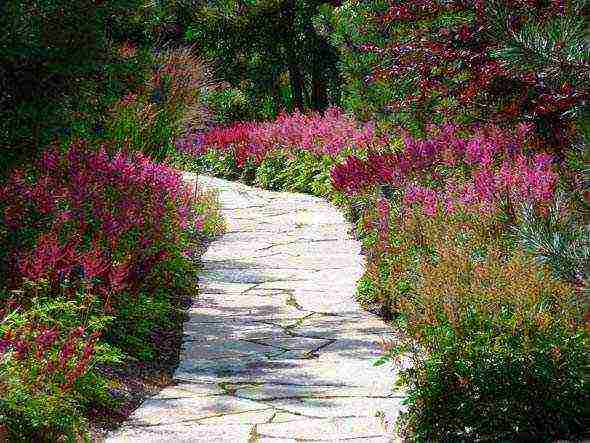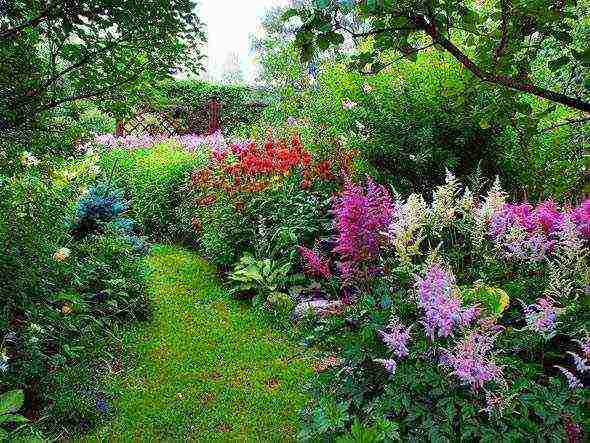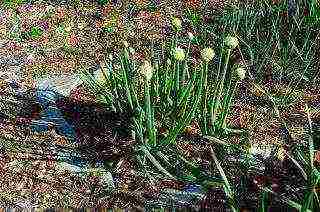Content [show]
I love astilba! Such a variety of species, colors and varieties of inflorescences can rarely be found in perennials. It can grow in one place for a long time. Attractive inflorescences remain on its bushes for a long time. The unpretentiousness of the plant allows even the most novice florist to grow it. Astilba is appropriate both in the dacha flower bed and in the front flower garden. For those who did not grow it on their site, we will tell you more about it - how the plant looks like, what species and varieties exist, how to choose and plant, how to care.
Description of the flower
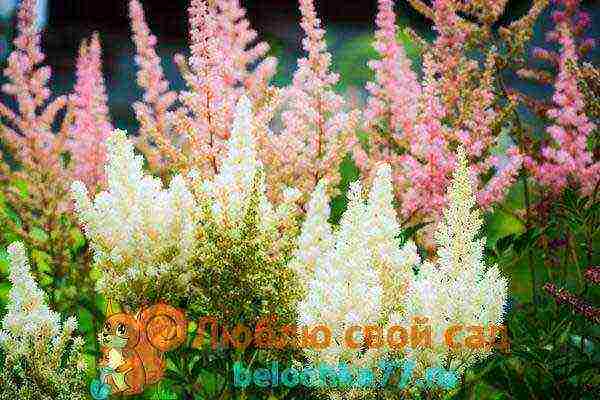
Astilbe (Astilbe) is a herbaceous perennial belonging to the genus saxifrage. There are up to 40 species in the world. This name was given to the plant by the Scottish botanist Hamilton - "A" means without, "stilbe" - shine - leaves without shine, matte, dull. Astilbe is considered the homeland of East Asia, North America, Japan. There the perennial grows in moist deciduous forests, along the streams. The Europeans were introduced to this plant by Karl-Thunberg and von Siebold. These hunters for unusual plants brought astilba home in the 18th and early 19th centuries. From that time on, she became a favorite of shady gardens.
Astilba is a rhizome, herbaceous perennial. The herbaceous part that has grown over the summer dies off in the fall. Erect shoots can grow from 8 cm to 2 m - depending on the species and variety. Serrated simple or feathery leaves sit on long petioles. The color of the leaf plate is from reddish green to dark green. The woody rhizome can be loose or dense, depending on the species. On the upper part, new shoots grow in spring, and the lower part dies off. Under a layer of snow, the plant tolerates frosts down to -37 ° C.
Small white, pink, lilac, purple or red flowers bloom on openwork apical panicles of various sizes. The peak of flowering occurs in mid-summer and lasts about a month. Small seeds ripen in a seed box - 1 g contains up to 20,000 seeds.
Astilba flowers, depending on the species, are collected in inflorescences of various shapes. They can be paniculate, rhombic, pyramidal, or drooping.

Astilba with paniculate inflorescences. Its numerous ramifications with many ramifications depart from the main axis at an acute angle and shorten towards the apex.
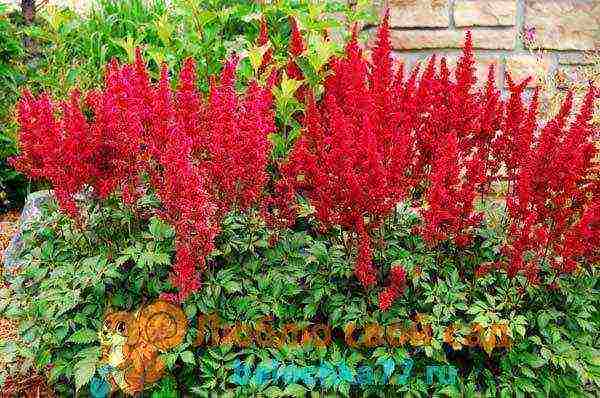
Astilba with pyramidal inflorescences - lateral branches extend from the main axis almost at right angles and evenly shorten from the base to the top, the inflorescence contour looks like a regular pyramid.

Astilba with rhombic inflorescences. Departing from the main stem at an acute angle form a rhombus. Such inflorescences are characteristic of Japanese astilba.
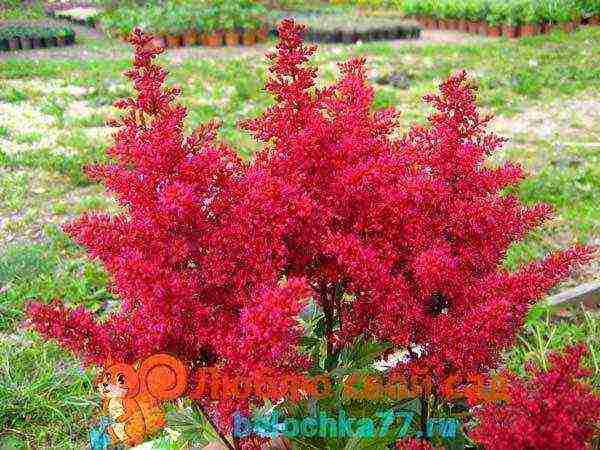
Astilba with drooping inflorescences in the form of arcs, gracefully hanging from the main axis. Such inflorescences are more common in Astilba Thunberg and Lemoine.

The decorativeness of the variety depends on the density of the arrangement and the size of the flowers. Inflorescences with several shades, such as "Peach and Cream", "Montgomery", "White Wings", look especially original.
Varieties with photos
Today, no more than 12 types of astilbe are used in garden design, from which many hybrids have been derived. The most famous of them are Arendsii Hybrida, Japanese hybrids (Japonica Hybrida), Chinese Astilbe Chinensis, and Astilbe simplicifolia.
Astilba arensa
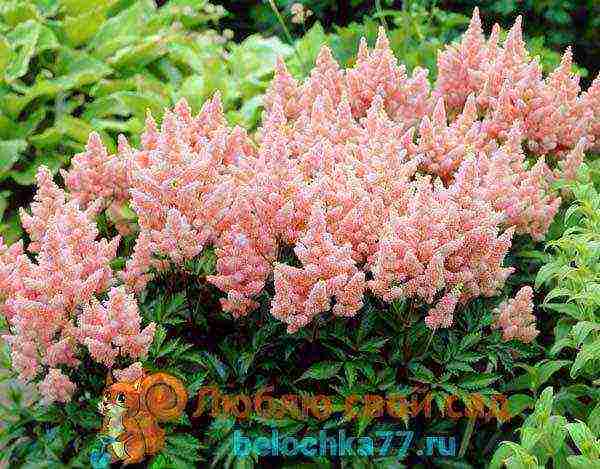 Astilba arensa
Astilba arensa
There are about 40 varieties bred by crossing David's Astilba with other species. Most of them are tall (up to 1m) plants, spreading pyramidal or spherical. White, pink, red or lilac flowers bloom above the dark green leaves. Flowering lasts more than a month from July to mid-August.
Japanese astilba
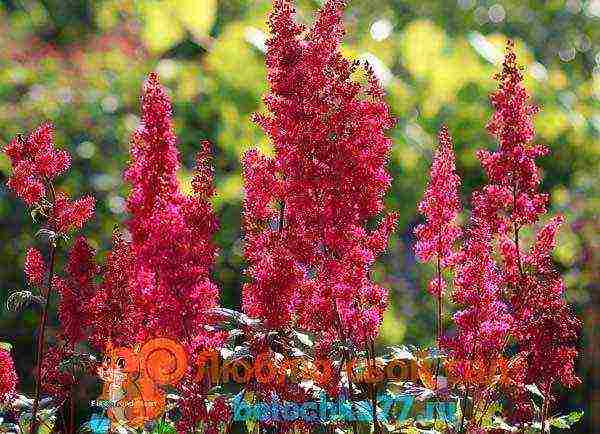 Montgomery variety
Montgomery variety
It most often does not grow taller than 80 cm. Compact bushes have shiny leaves, panicle inflorescences of pink or white. This variety of astilbe begins to bloom earlier than anyone else, dried flowers retain their attractiveness until the end of the season. New varieties are unpretentious to growing conditions, resistant to low temperatures.
Cultivated varieties: Deutschland - white panicles, pink Rhineland, soft lilac and elegant Europe, Montgomery with bright red or burgundy fluffy panicles.
Chinese astilba
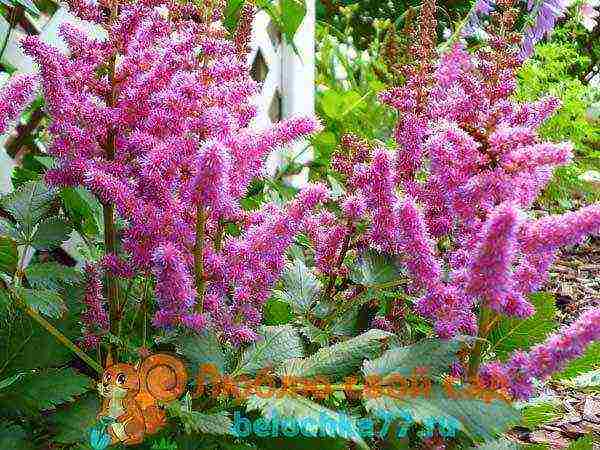 Vision in pink
Vision in pink
It is a herbaceous shrub about a meter high. Leaves of different sizes - growing from the base of the bush, large, on long petioles, growing on the stem - smaller, with short petioles. Dense inflorescences can grow up to 30-35 cm, most often lilac, less often white or pink. They can grow in sunny flower beds. The most famous varieties: "Purpurlanze" of an unusual lilac color, pink "Vision in Pink", "Vision in Red" dark purple.
Astilba ed
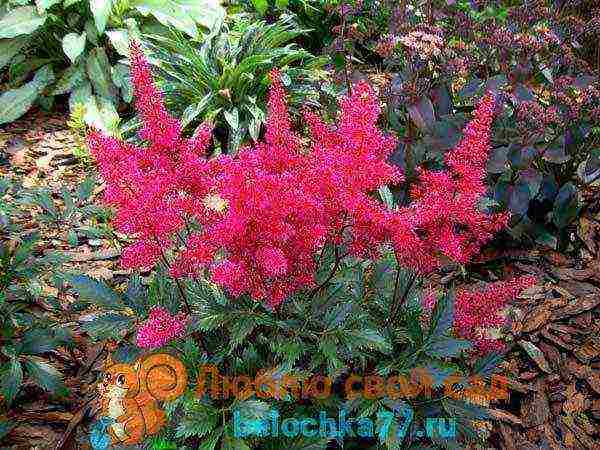 Astilba ed
Astilba ed
Astilba gloria
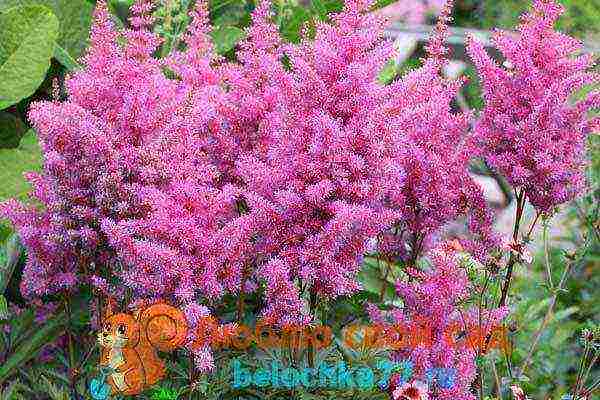 Astilba gloria
Astilba gloria
Astilba white
 Astilba white
Astilba white
Astilba amethyst
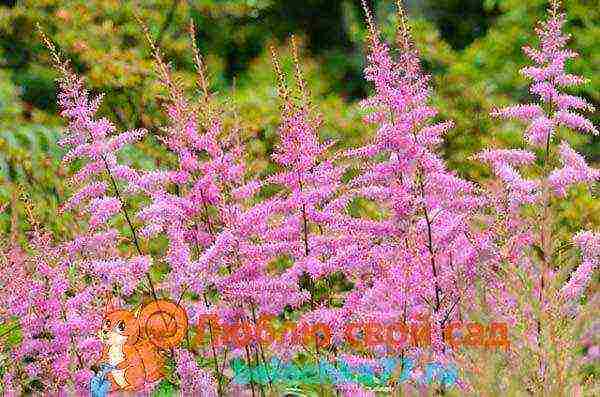 Astilba amethyst
Astilba amethyst
Astilba common
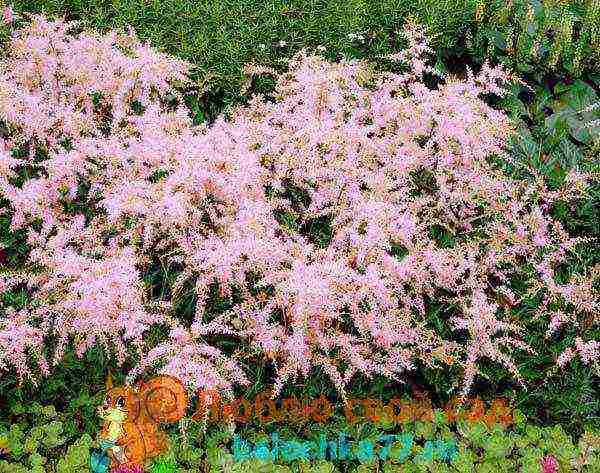 Astilba common
Astilba common
Plants of this species and varieties derived from them are very sensitive to high temperatures and low air humidity. The drooping inflorescences of these low plants (up to 50 cm) give the plantings a special airiness. Bred varieties with white candles of inflorescences - Praecox Alba, pink - Bronze Elegans, coral Ostrich feather.
Astilba unique
 Younique silvery pink
Younique silvery pink
In the 2000s. a new group of varieties, Younique, was created. This group includes varieties with snow-white, purple Younique Lilac, pink Younique Silvery Pink and almost red graceful Younique Carmine inflorescences. The inflorescences of these varieties are both delicate and lush, without a long peduncle, growing from the mass of leaves.
When to plant astilba?
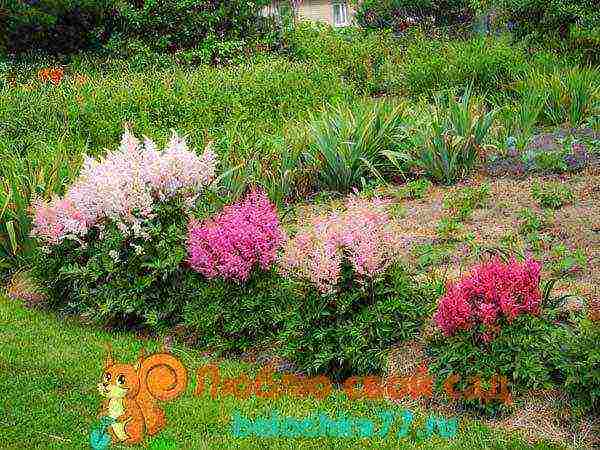
In order to admire the flowering of astilba every year, it must be transplanted in a timely manner and planted on time.
The most suitable time for this event was recognized as the end of summer (August) - beginning of autumn.
The flowering of the plant has already ended, and the cold weather is still far away - the plant will have time to take root and prepare for wintering.
The experience of many gardeners recommends planting and dividing astilbe bushes after 4 years. A feature of astilbe can be considered their gradual protrusion from the soil - the rhizomes grow upward, dying off from below. After a while, the roots become bare. This phenomenon can be eliminated by annually adding soil or compost to the bare rhizome. This procedure allows you not to transplant the plant, but only to divide and plant.
The choice of planting material (how to save after purchase before planting)

Many growers purchase Astilba seedlings via the Internet or at garden centers. Plants in such trading companies are packed in bags, which in most cases are stored in a dark place. The rhizomes germinate, but the resulting shoots stretch out from lack of light, turn out a pale green color and bend. Planted in open ground, such seedlings are sick for a long time and do not take root well.
Advice. It is worth purchasing planting material as early as possible, as soon as the seedlings are on sale. Store in the refrigerator until planting, periodically checking its condition.
Storing the seedlings in a cool place will keep the buds from germinating.
From the whole set of bags with rhizomes, it is worth choosing those in which it is clear that the seedlings are alive, the shoots are small, fresh and green. Saplings with long, pale and thin shoots will also take root if the rhizome is not dry and rotten. In the first year of life in a flower bed, such a plant will adapt to new conditions for a long time, will give a weak growth and will not bloom.
The largest selection of astilba planting material in chain stores can be observed at a time when it is still far from planting plants in the ground - in February - March. How to preserve the acquired rhizomes until the time when they can be planted in open ground?
Astilbe can easily transfer home content before planting in a flower garden. One storage option is a household refrigerator or basement. We need a positive temperature close to zero. Plastic containers with ventilation holes are filled with a damp substrate such as sawdust, coconut fiber, light earth or moss. Rhizomes are laid on the surface and slightly covered with the same substrate. In this state, the astilbe will survive until spring without loss.
Rhizomes, which buds have awakened and sprouts have appeared, can be planted in a flower pot and placed on the windowsill. Water as needed, avoiding waterlogging. It is necessary to plant seedlings with regrown leaves in a flower garden after the end of the frost. At first, such plants need to be protected from excessive sun.
Landing
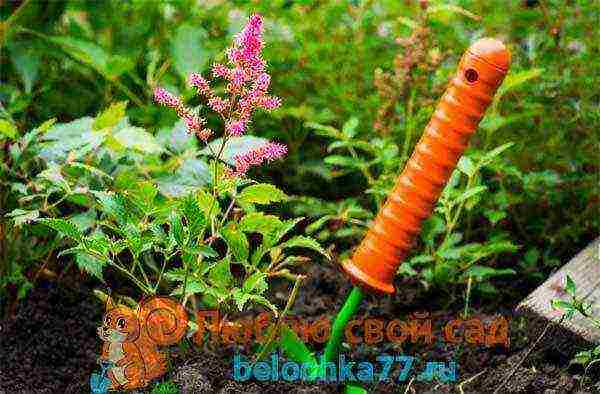
Planting any plant begins with choosing a place. For astilba, light shading, partial shade is needed. In an open sunny meadow, Astilba will feel uncomfortable. The flowering of perennials in such places is more abundant, but ends faster and the shoots have a paler color.
The choice of the planting site is also influenced by the flowering period of the seedling. Early and late flowering varieties bloom equally in sun and shade. Shaded areas are more suitable for mid-flowering varieties, where the astilba will be protected from the hot midday sun.
Loamy soil, pH 5.5-6.5, and the surrounding air should be moist. The perennial will be especially grateful for the close location of groundwater. Only astilba Chinese can tolerate a slight drying out of the soil. For other species, the dried soil of death is similar. A perennial will feel very good on the shore of a decorative reservoir.
The best spring planting date is May-June.
Preparing the site for planting, they dig it up, remove the roots of perennial weeds, add 2 buckets of organic matter per 1 m2
Preparing the landing hole. Its size should be such that the seedling rhizomes can freely settle in it. The bottom of the hole is loosened, we pour organic matter, you can spill it with liquid Biohumus or any other fertilizer diluted according to the instructions. In areas where a lack of moisture is possible in summer when planting, hydrogel granules can be added to the soil.
We put the rhizome on the prepared soil. The planting depth should be such that there is 4-5 cm of soil above the base of the sprouts. It is necessary to sprinkle the seedling with a substrate, taking into account the fact that the watered soil will settle and the roots may appear on the surface. The hole around the seedling will not allow water to spread over the surface, but will direct it to the roots.
Mulch in the planting hole will retain moisture and make it easier for the plant to adapt to its new location.Spreading a protective layer of 3-4 cm around the sprouts leave a place free of mulch. As such a layer, you can use humus, sawdust, needles or crushed bark.
In dry weather, astilba will need to be watered every other day before the young leaves appear.
When planting perennials in groups between neighboring plants, leave from 40 to 50 cm of free space.
Landing astilba: video
Care

Planted on fertilized soil, astilba grows in one place for up to seven years. With careful care and timely feeding and watering, this period can increase to twenty.
In the spring, after the snow melts, the plantings are fertilized. Liquid fertilizers quickly enter the root layer. You can mulch seedlings with organic material. During the entire growing season, it is necessary to maintain soil moisture at the proper level.
When the flowering of astilba is over and the peduncles are dry, it is better to leave them on the plant - even in a dried form, they look impressive. When preparing plantings for winter, the aerial part of the perennial is cut off at ground level and the plantings are covered with them. For additional protection of the bush from frost, you can use coniferous spruce branches or tops of vegetable plants.
From the moment of emergence in spring until mid-summer, it is very important to remove weeds in the plantings. Towards the end of summer, astilba rhizomes grow so much that they can strangle the weeds on their own.
Diseases and pests

Astilba, as an alien from another climatic zone, did not create a large number of enemies among insects and microorganisms in our latitudes. The greatest harm to this perennial is caused by the slobbery penny and two types of nematodes - gallic and strawberry.
The stump in the axils of the leaves creates foam-like nests for its larvae. Under the influence of the pest, astilbe withers. Any insecticidal preparation can destroy the pest.
Plants damaged by strawberry nematodes become covered with necrotic spots, their buds, leaves and flowers are deformed.
Gall nematode parasitizes on the roots, where gall outgrowths are formed, inside which nematodes live. You can notice the parasite on the roots only in the second year of life. Plants with nematodes on the roots lag behind in development, bloom poorly and may die. Perennials infected with nematodes must be removed from the flower garden in a timely manner.
Preparing Astilba for winter

It is necessary to prepare a newly planted astilba bush for wintering in advance - in the summer. In plants of the first year of life in a new place, the peduncle is removed as soon as it is isolated. Throughout the season, soil is weeded around the bush and weeds are removed. When loosening the crust on the soil surface, you need to do it carefully, trying to keep the young roots intact.
After the first autumn frost, the blackened leaves are cut off at ground level and placed on the growing bushes. Then, an earthen mound about 4 cm high is created above the bush, and then fill the place of growth of astilba with dry leaves or peat. Crushed bark or humus is also suitable.
On the bushes of the second and subsequent years of life, flower stalks are left, and for the winter they are insulated with peat or fallen leaves in the same way. Every year, the rhizomes of astilba rise higher and higher and soon begin to bulge out of the ground, becoming defenseless against the winter cold. Astilbe, frozen in winter, become less decorative.
Four-five-year-old astilbe plants are fully covered before the onset of frost. To begin with, cut off the foliage and flower stalks. At the next stage, a frame is built into which insulation can be laid - dry leaves or tops. You can fix the leaves in the frame with nonwoven spunbond or lutrasil. You need to protect the planting from getting wet with plastic wrap pressed along the edges.
A strong, healthy plant will more easily endure winter colds and return frosts.
It is possible to increase the immunity of astilba with the autumn application of potash and phosphorus fertilizers. Under each bush, 50 g of a mixture of fertilizers are scattered in a 1: 1 ratio. Good results are obtained by using well-rotted organic matter - manure or compost.Slowly decaying organic matter warms the bush in winter and provides food in an accessible form in summer.
Blackberry mushroom - photo and description of how to cook
Reproduction
There are several ways of reproduction of astilba: seeds, renewal buds and division of the bush. Most often they are propagated vegetatively - by dividing the bush, but when propagated by seeds, you can get new varieties, start breeding.
Seed reproduction

Astilba seeds are so small that they can only be seen through a magnifying glass. To collect 1 g of seeds, you need to collect 20,000 pieces. Ripe seeds are quickly poured out of the seed pods. To collect seeds, the inflorescences are cut in September and put on paper in a warm, dry place, and kept from two weeks to a month. The spilled seeds are collected and stored in a paper bag.
With seed reproduction, sowing begins in March. The container is chosen wide, with a depth of about 15 cm. A mixture of peat and sand in a 1: 1 ratio is used as a soil. Snow is poured onto the soil, in a layer of 1 cm. You can replace natural snow with artificial one - from the freezer. You can evenly distribute the seeds over the surface of the snow by mixing them with liquid. Seeds are poured into a growth stimulant solution and sown with a pipette over the surface of the snow. On a white background, the seeds are especially visible and can be distributed more evenly. The melted snow will moisten the soil and tighten the seeds to the desired depth.
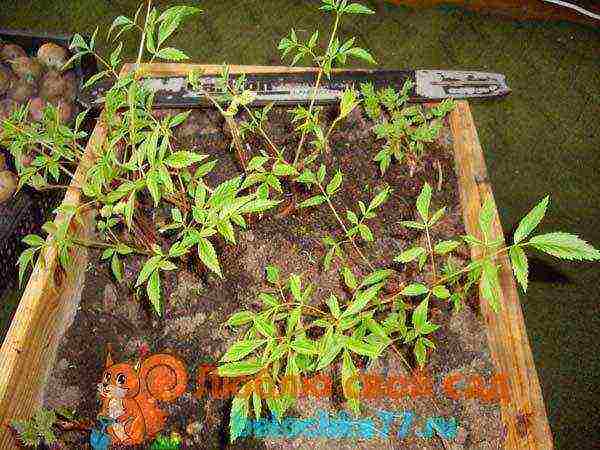
After waiting for the snow to melt, a container with seeds in a transparent bag, or even better wrapped in plastic wrap, is placed in the refrigerator for three weeks. During this time, seedlings appear in the container. The greened container is transferred to a warm, bright place. Especially carefully you need to water the sprouts - you can water with a spray bottle and a fine spray of water or a syringe without a needle. Seedlings with 2-3 true leaves are cut into separate pots, and subsequently planted in the ground.
Sowing astilba seeds: video
Renal reproduction renewal
- With the beginning of the growth of shoots or buds of renewal, they are cut off with a piece of rhizome.
- Wounds are disinfected with crushed charcoal or cinnamon powder.
- Sections with buds are planted in a mixture of gravel and peat, in a ratio of 1: 3 and covered with polyethylene (film or a cut bottle).
- In the fall of the current year or in the spring of the next, the seedlings are transplanted to a permanent place.
Reproduction by dividing the bush
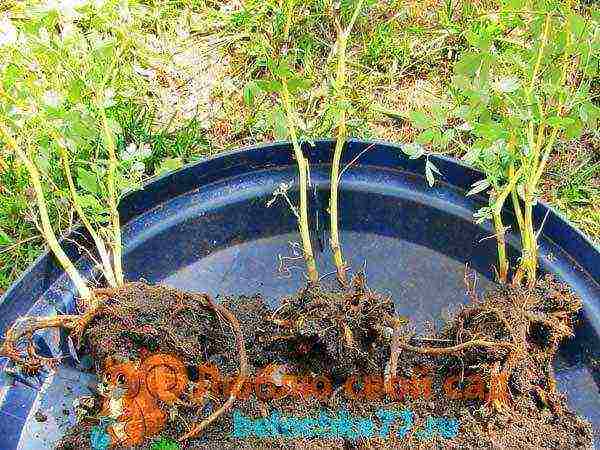
The easiest and most reliable way to propagate astilba vegetatively is by dividing the bush. The best results are given by bushes at the age of 3-4 years. The rhizome of a perennial dug out of the ground is divided into parts with a pruner or a shovel. At least two buds should remain on each division. The lower parts of the rhizome are removed. The resulting parts of the plant are planted in new places or wrapped in a damp cloth and kept in a plastic bag, preventing the roots from drying out.
It is better to divide and plant astilba in early spring, before flowering. It is necessary to reproduce a perennial in autumn in such a way that the plant has enough time for rooting before the onset of frost, i.e. in August and early September. Plants tolerate the division procedure well, quickly take root in a new place and bloom the next year.
Astilba: growing, care, reproduction: video
Hosta - planting and care in the open field
Astilba in landscape design

Landscape designers value astilba for its long-lasting decorative effect, resistance to high groundwater levels, and the ability to grow in the shade of tall plants. The delicate leaves that sit on reddish cuttings attract attention throughout the garden season.
Young purple leaves look attractive in the flower garden, which gradually turn green and acquire an unusual shape. An additional bonus to the carved leaves is a long, more than a month, flowering. Various shapes and shades of inflorescences adorn the flower garden from mid-summer to autumn.
Astilba in the creation of flower arrangements can be used both individually and in group plantings, combining the colors and sizes of different varieties.
Planting in groups
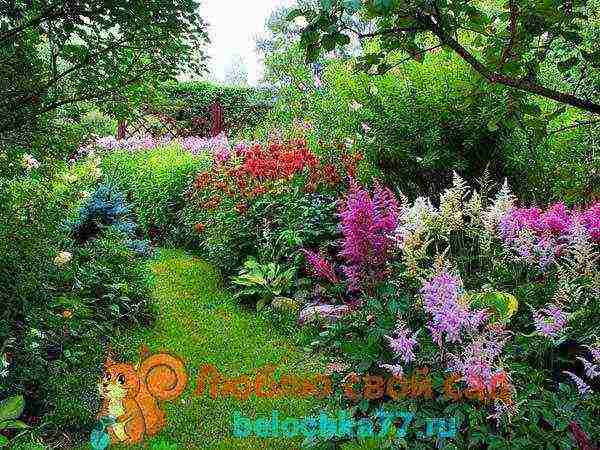
Astilba is a versatile person, it will be desirable in any landscape design.Low-growing bushes can be used in the foreground of the composition, medium-sized ones will decorate the middle and background of the plantings. Tall ones will decorate what you want to hide, disguise outbuildings or an unsightly fence. Low-growing varieties will be appropriate on an alpine slide or scree. They can also frame garden paths.
Clarkia graceful - growing from seed
Planting in flower beds
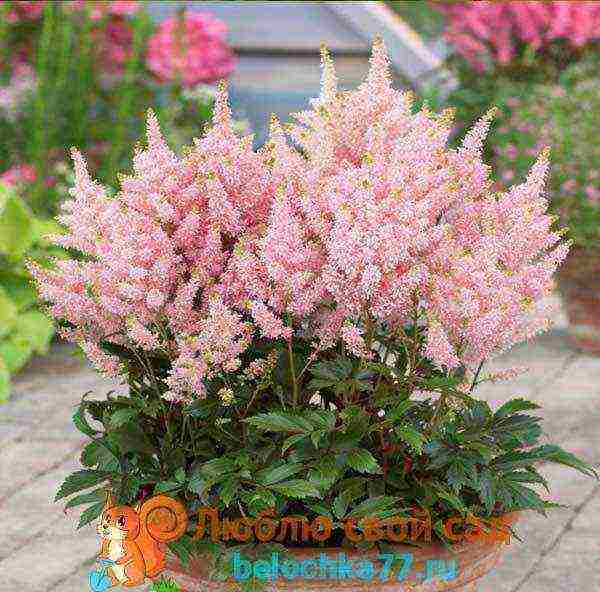
Low-growing varieties of astilba can be used as a border for flower beds and lawns. An astilba bush in a flower pot will decorate an open veranda or garden gazebo.
This perennial looks spectacular against the background of conifers, such as thuja or junipers. A successful combination of astilbe with hosts and ferns.
Carved perennial leaves will look even more delicate in joint plantings with hellebore, berry, podophyllum, rogers or cuffs. A very interesting combination of astilba with daylilies, aquilegia, lilies, geraniums, phlox or ferns. Planted together with the hosta, astilba emphasizes the beauty of its leaves, and the leaves retain the moisture of the soil for astilba.
The joint planting of astilba and ground cover plants (saxifrage, tenacious, lamb) achieves two goals - in early spring, when the astilbe is not yet visible, the ground cover creates an attractive spot, then the grown and colored astilbe attracts attention. In the hot season, the ground cover protects the place where the astilbe grows from overheating.
In the spring garden, astilbe planting is combined with primroses, crocuses, lilies of the valley, rhododendrons, tulips.
Planted in the company of tall flowers, astilba camouflages the bare stems of its neighbors. It belongs to rare ornamental plants that grow and bloom beautifully in conditions of lack of sun and excess moisture. If necessary, you can plant astilbe under trees, but you need to do this, stepping back from the tree trunk at least 1.5 meters. With such a planting, the roots of the tree will not be damaged and the astilba will not be depressed.
Badan - planting and care in the open field
Forcing astilba

You can also enjoy the flowering of astilba in winter. For this, it is enough to distill.
Most willingly, at home, two - three-year-old bushes will bloom. Suitable bushes are dug out at the end of September and, divided into two or three parts, are planted in flower pots with a diameter of at least 13 cm. The substrate needs loose and nutritious - sod land, leafy soil, compost and sand (2: 2: 2: 1). The planted plant is watered and placed in a greenhouse. For the winter, the planted astilba is insulated.
The pot is brought into the heat at the end of December and left in a cool place at a temperature not higher than +12 degrees. Watering should be done in moderation. Shoots appear after about twenty days. The plant is transferred to a warmer room, where it is about +20, watering is increased. In a month - one and a half astilba can bloom. One bush can grow up to seven full-fledged inflorescences.
If the emerging shoots, which have grown to 8-9 cm, are sprayed with growth stimulants, then the beginning of flowering will accelerate. Gibbersib allows you to get flowers for 17-21 days, increase the number of inflorescences and the length of the pedicel. Astilba flowers become exquisitely graceful.
Subsequently, the bush can be transferred to the open air, or it can be grown indoors.
Planting and caring for astilba is not difficult. Grow this bright perennial and delight yourself with astilba flowers.

Lush astilbe bushes will decorate the infield. They are actively used in landscape design. Planting and care is simple, available even to beginners in floriculture.
Content:
Description
Astilba belongs to the saxifrage family... The genus includes about 40 species, consisting of 400 varieties. Of all the variety, only about 40 pieces have become widespread.
In natural conditions, it grows in North America, Japan, East Asia. You can meet her in the lowlands, near rivers, in deciduous forests. The plant loves moist soils.
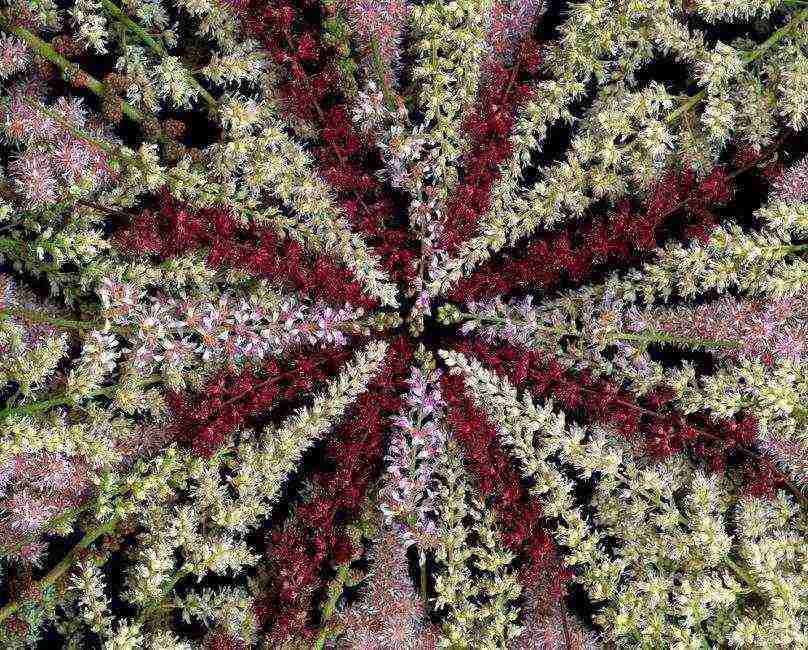
Astilbe type refers to rhizome plants
Woody roots. New buds are formed on them every year, the old part slowly dies off.
Its stems are erect.They grow from 10 cm to 2 m... Their life cycle lasts from spring to autumn.
Astilba leaves grow on long petioles. Their plates are cut twice or thrice. There are denticles along the edges. They are painted in a dark green color, some varieties may have a reddish tint.
The inflorescence is represented by panicles, which grow up to 60 cm long. They consist of small flowers. Their color can be white, pink, red, purple.
The flowering period is in the summer months. It lasts about 14 days. After it, the fruit-box with seeds ripens.
back to menu ↑ Views 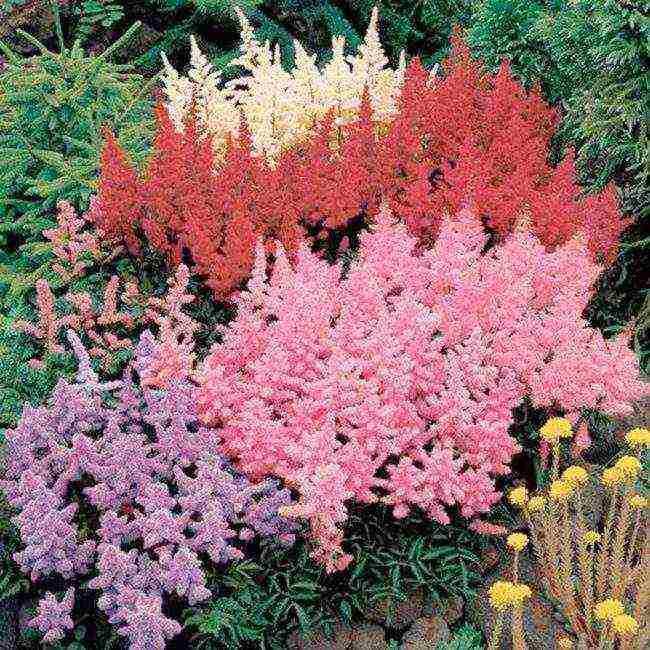
Types of Astilba
Scientists use several classifications of astilba: by origin, by name, by color of inflorescences, flowering period, height of bushes and others.
Height classification:
- Dwarf, up to 30 cm
- Low, up to 60 cm
- Medium, up to 90 cm
- High up to 2 m
Inflorescence classification:
- Diamond-shaped
- Paniculata
- Pyramidal
- Drooping
Flowering Period Classification:
- Early
- Average
- Late
Let us dwell in more detail on the classification by origin. It is accepted by botanists as a basis.
back to menu ↑ Arends 
Astilba Amethyst
Arends
- Combines 40 varieties. They are represented by perennial plants with a powerful, branched root system. The bushes grow up to 1 m in height, the cross section is 70 cm. The crown is either pyramidal or spherical. The leaves are feathery, green with a glossy sheen.
- The hybrids of this series are obtained by crossing David's Astilba with other varieties.
- The group has a long flowering period, up to 40 days. It falls in the second half of the summer.
The series includes such varieties as:
| Amethyst | 80 cm | Paniculata | Light lilac | July | 25-30 days |
| White Gloria | 80 cm | Diamond-shaped | Purple | July | 25-30 days |
| Brautschleier | 70-80 cm | Drooping | Yellowish white | First half of July | 16 days |
| Glut | 70-80 cm | Paniculata | Red | August | 15-20 days |
| Diamond | 90 cm | Paniculata | White | July | 25-30 days |
| Anita Pfeiffer | 60-80 cm | Paniculata | Salmon Pink | July | 30 days |
| Erika | 85-90 cm | Rhombic | Light pink | Second decade of July | 14 days |
| Hyacinth | 80-90cm | Rhombic | Light lilac | Second decade of July | 14 days |
| Ruby | 80 cm | Paniculata | Purple | July August | 18-25 days |
| Bressingham Beauty | 80-100 cm | Paniculata | Hot pink | July August | 30 days |
| Gloria Porpurea | 70 cm | Paniculata | Dark lilac pink | July August | 20-30 days |
back to menu ↑ Astilbodes 
Astilba Blond
Astilbodes
- The group includes 3 varieties bred by E. Lemoine: Blond, Keningin Wilhelmina, Lord Salsbury and 1 variety - M. Debois: Floribunda.
- Their height is 60-90 cm. The leaves are large, twice dissected. Their color is light green. The veins on the sheets are covered with hairs on both sides.
- The flowers are white or pink, forming a pyramidal inflorescence. It is 45 cm long and 20 cm wide. Lateral branches are drooping. Flowers have 10 stamens.
- The flowering period is from June to July.
- Withstand frost down to -23 degrees. In regions with colder winters, shelter is required.
- These varieties are rarely found in flower beds. It is almost impossible to find them on sale. These varieties formed the basis for new varieties.
back to menu ↑ Low hybrids of Astilba Chinese 
Astilba Serenade
Low hybrids of astilba chinese
- Representatives of this group are distinguished by a late flowering period. They open their flowers in August - September.
- The group of Chinese hybrids includes the variety used in breeding, which is the basis of Arends' series - David's astilba. She has powerful, tall bushes - 150-200 cm. The stems are red-green in color.
- Leaves when blooming in spring have a bronze tint, later become light green. The color of paniculate inflorescences is lilac-pink or fuchsia.
- Flowering lasts 14 days in July.
The table shows the popular varieties of this series:
| The final | 40 cm | Paniculata | Pink | -25 | 25 days |
| Intermezzo | 60 cm | Paniculata | Salmon pink | -25 | 25-30 days |
| Serenade | 100 cm | Paniculata | Lilac pink | -30 | 25 days |
| Veronica Klose | 40 cm | Paniculata | Dark pink | -27 | 25-30 days |
| Purplekerts | 100 cm | Paniculata | Purplish pink | -25-30 | 30 days |
| Spatsommer | 40 cm | Spicate | Pink | -30 | 30 days |
back to menu ↑ Fringed hybrid 
Astilba Lilliput
Fringed hybrid The group consists of Arends varieties. Their difference is in openwork, strongly feathery leaves. These varieties are distinguished by very decorative inflorescences, graceful shapes.
Common varieties:
- Dagalet - with the onset of autumn, the leaves are covered with a bronze color. It blooms with cream flowers.
- Lilliputian Is a dwarf variety with salmon pink flowers.
- Perkeo - a compact plant, no more than 20 cm high. Pink or purple flowers make up narrow pyramidal inflorescences. Blooms in the first half of July, a little over two weeks. The leaves have a bronze tint in the spring.
- Peter Pan - has bright pink pyramidal inflorescences
back to menu ↑ Hybrid varieties 
Astilba America
Hybrid varieties
- The group includes about 50 varieties. It is one of the most numerous.
- This includes all astilbe that cannot be attributed to other groups.
Consider a few of the most famous among flower growers:
| America | 70 cm | Paniculata | Light pink | July | 18 days |
| Avalanche | 60 cm | Drooping | White | July | 20 days |
| Rubella | 90 cm | Paniculata | Light purple | July | 14 days |
| Kwele | 60-80 cm | Paniculata | Lilac pink | July | 20 days |
back to menu ↑ Japanese hybrids 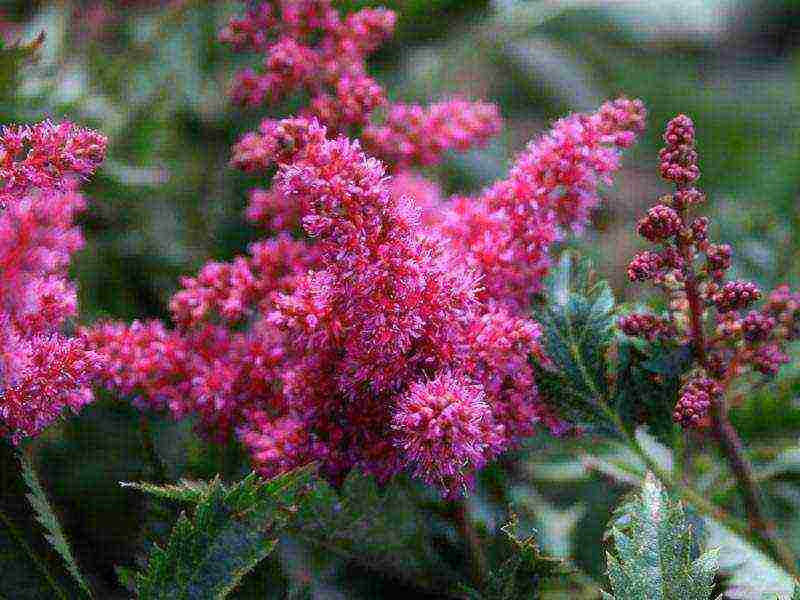
Astilba Bremen
Japanese hybrids
Low bushes grow up to 90 cm. They have shiny leaves. The bushes are highly spreading with a large number of side shoots. Most flowers bloom early. Representatives of this group are used for distillation.
Description of some varieties:
- Bremen bushes grow up to 50 cm. Raspberry inflorescences have a pyramidal shape. The flowering period is July - August.
- Gladstone grows up to 50 cm. Inflorescences are creamy white, drooping. Flowers bloom in July.
- Montgomery blooms in late summer. The inflorescences consist of large red flowers. Its bushes grow up to 70 cm.
- Plume has drooping inflorescences, painted in cream or light pink. The growth of the bush is 80 cm.
back to menu ↑ Lemoine hybrids 
Astilbe mont blanc
Lemoine hybrids
- This series includes about 20 varieties.
The most common:
| Gerbe de Neige | 95 cm | Drooping, up to 50 cm long | Cream | July | 25-30 days |
| Mont Blanc | 60 cm | Pyramidal | White | End of July-August | 20 days |
| Plume Neijo | 80 cm | Drooping | White with a pinkish tint | July | 18 days |
back to menu ↑ Pink hybrids 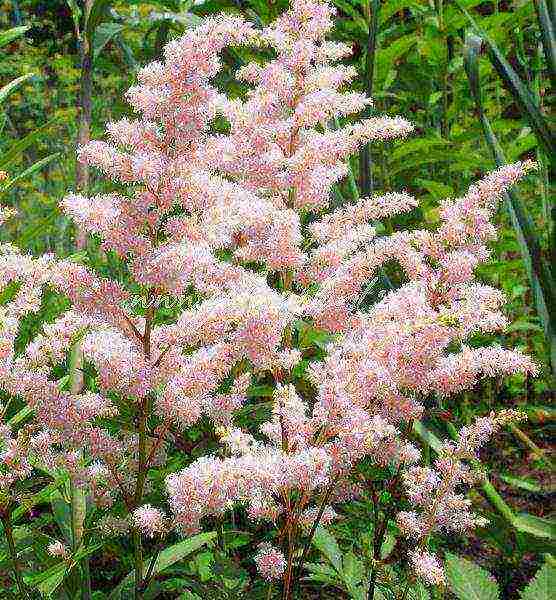
Astilba Queen Alexandra
Pink hybrids
This group includes 2 varieties:
- Peach Blossom - differs in spreading bushes, the height of which is about 60 cm. Paniculate inflorescences are 10-25 cm long. They are painted in light lilac. Bloom for about 15 days in July. The frost resistance of the variety is high.
- Queen Alexandra - the height of the bush is 60 cm. The color is pale pink. Flowers are collected in paniculate inflorescences.
back to menu ↑ Prostate hybrids 
Astilba Aphrodite
Prostate hybrids
The group consists of 16 varieties. The main thing is that their difference is simple, not delicate, leaves. Bushes do not exceed 50 cm in height. These hybrids do not tolerate hot weather very well, they are suitable for regions with cool summer weather. It is better to plant them in the shade.
Common varieties:
- Aphrodite refers to dwarf varieties, the height of its bush is on average 40 cm. The color of the inflorescences is raspberry.
- Bronze Elegance grows up to 30 cm. The drooping inflorescences are pale pink in color.
back to menu ↑ Astilba Take 
Astilba Superba
Astilbe Take
- Small group... The most famous variety included in it is Superba. Its bush is 1 m tall. Panicle inflorescences are painted in lilac-pink color. Belongs to varieties of late flowering, it takes place in August, for 25 - 30 days.
- The variety is frost-resistant... Withstands temperatures up to -30 degrees.
back to menu ↑ Astilba Thunberg 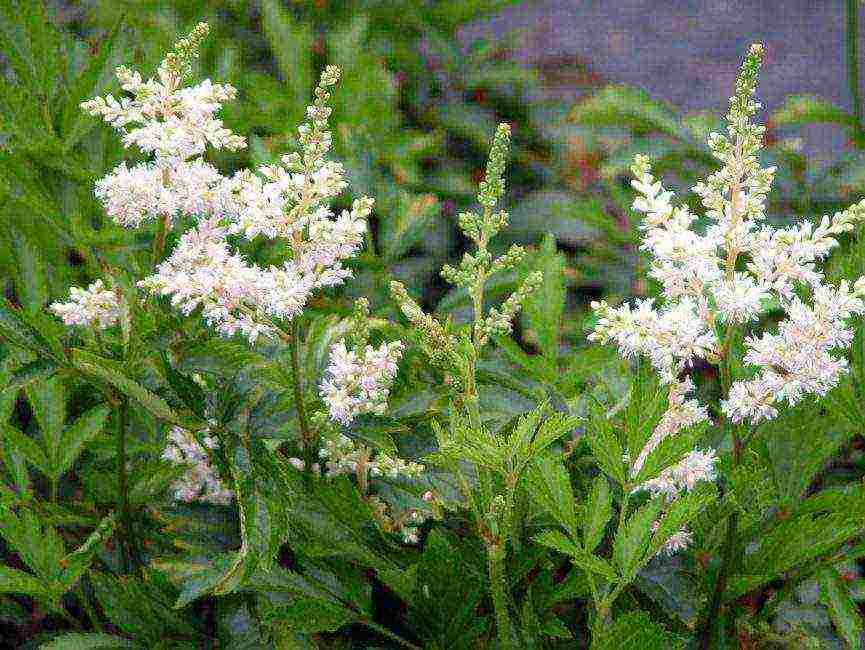
Astilba van der Willen
Astilbe of Thunberg
The group includes varieties that were bred by G. Arende and B. Reis. The inflorescences of these hybrids reach a length of 25 cm. The flowers of the series have a pleasant smell. These varieties have a rather low frost resistance, they must be covered for the winter.
- Betsy Couperos - a rather tall bush, its height is 120 cm. Flowers form light pink panicle inflorescences. They bloom in August.
- Professor van der Willen - grows up to 90 cm. The color of the leaves in the spring is brownish-green. The inflorescence is drooping, about 40 cm long.The color can be white or yellowish white. Blooms in July for 15 to 20 days.
- Straussenfeder differs in tall bushes up to 180 cm. Dark pink inflorescences have a drooping shape. It blooms for 20 days in July - August. The variety tolerates frosty weather well.
back to menu ↑ Naked hybrids 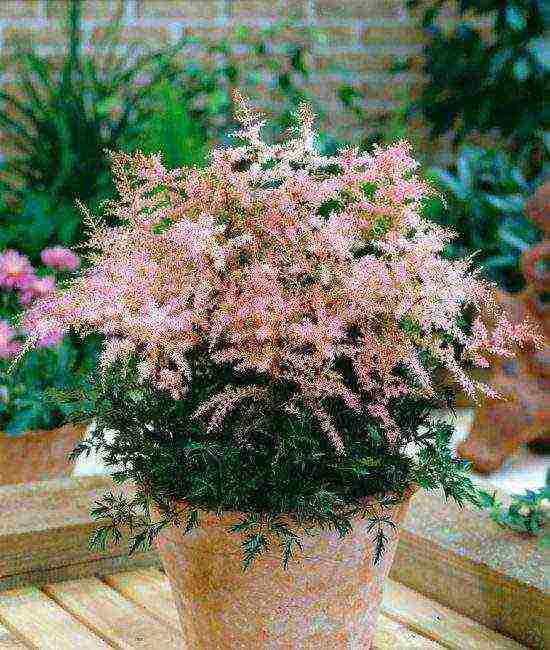
Astilba Sprite
Naked hybrids
The varieties are native to southern Japan. They do not tolerate frost... Maximum frost resistance up to -23 degrees. All varieties of this group are dwarf, the height ranges from 15 to 30 cm. Suitable for forcing.
Flowers are collected in panicles, loose structure. The flowering period coincides with the middle of summer.
These include varieties:
- Sprite - grows in round bushes with a lot of branches. Their height is up to 50 cm. The inflorescence is represented by drooping panicles. They consist of small pink flowers.
- Saxatile - low plant, 8-15 cm tall. Their root system has many offspring. Flowers form panicle inflorescences. Their color is lilac-pink. The bush gives few inflorescences, they are loose and scanty.
back to menu ↑ Reproduction of astilba
Astilba can be propagated in three ways:
- Seeds
- By kidneys
- Dividing the bush
back to menu ↑ Seed propagation method
Astilba, which grows in gardens, a representative of hybrid varieties... It is created by crossing by professional breeders. This process involves special technologies.
Seeds collected from their own bush or from friends will lose their decorative qualities. They have poor germination. Those specimens that will sprout will not have the qualities of a mother plant. They can change not only the brightness of the flowers, but also the leaves. They will be weak and susceptible to negative environmental factors.
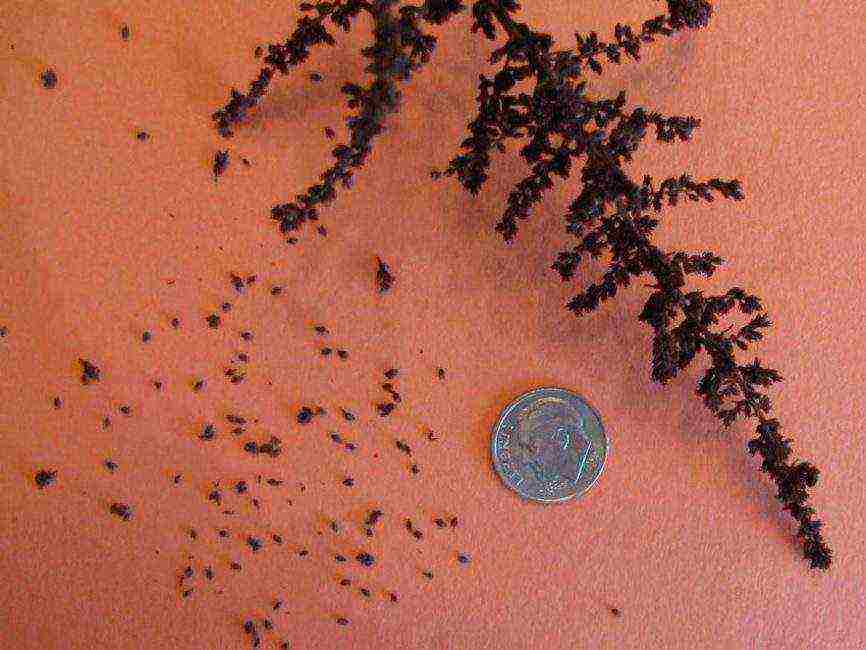
Astilba seeds
The best selection of seeds would be those provided by a reliable, proven manufacturer. When there is no way to buy the species you like, you can take the risk - plant your own. Astilba seeds are not easy to collect because they are very small. 20 thousand seeds by weight is only 1 g.
There are a few rules to follow:
- Ripening occurs in September, earlier it makes no sense to collect them
- Faded inflorescences are cut and laid out on sheets of paper
- Ripening lasts 2 weeks in a warm place
- When the panicles are completely dry, shake them. The seeds will spill out onto the paper
- Planting is done in spring
Before sowing seeds in the soil, they must be subjected to a stratification procedure:
- Place the seeds on a damp piece of cloth
- For greater effect, it is recommended to mix them with sand, peat, or layered with cotton
- Wrap the fabric and place in a plastic bag
- Withstand at a temperature of 0 + 5 degrees. To do this, you can put them in the refrigerator door.
- Astilba seed stratification can take up to six months
Purchased seeds are also cooled. Several days are enough for them.
After the seeds have sprouts, they can be planted in containers filled with soil. The ideal substrate is a mixture of sand, peat and leafy soil, in a ratio of 1: 1: 2.
The sown seedlings are kept indoors at a temperature of + 18 + 20 degrees. The first shoots will appear in about 15-20 days. They are white and covered with hair.
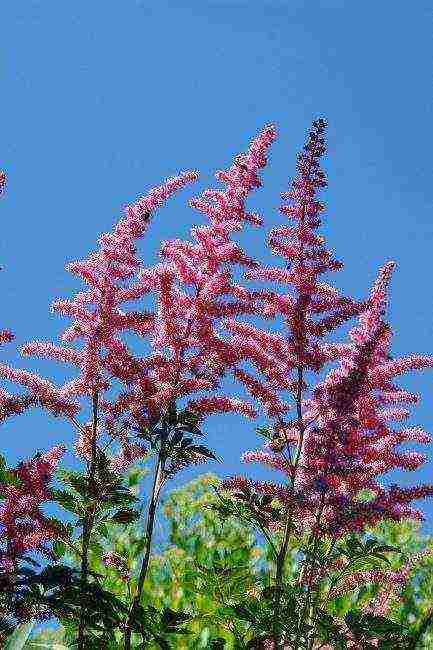
Astilbe
INplanting in open ground is carried out after the formation of the first full-fledged leaves... The planting site should be shaded so that the direct rays of the sun do not burn young plants.Astilba does not tolerate drought... And mature plants, seedlings need regular watering.
Bushes grown from seeds bloom after 3 years. This method is the longest.
back to menu ↑ Reproduction by kidneys
Separation by the kidneys is recognized as the most effective way of reproduction of astilba. It is held in the spring. Bushes get sick less, their survival rate increases. They begin to bloom earlier than those planted with seeds.
The process is root division... Each root cut should have several renewal buds. Sections must be processed with ash.
Cuttings are planted in a greenhouse... The soil should consist of gravel and peat, the proportion is observed 1: 3, respectively. The depth of the planting hole should correspond to the size of the planting material. The ground should completely cover the buds by 0.5 cm.
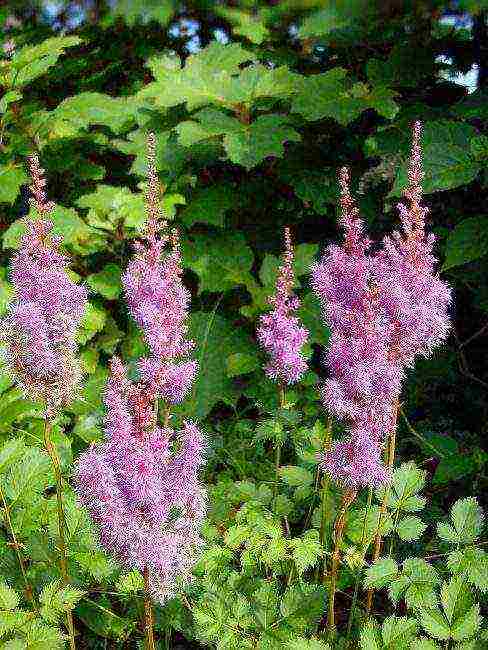
Astilbe in vivo
The plant takes root throughout the year... After that, in the spring, it can be planted in a permanent place in open ground. It is possible to plant immediately in the place where the constant growth of astilbe is planned. Then it is necessary to mulch the planting. From above it is covered with a film.
When choosing such a planting, you need to fill the dug hole with the prepared soil mixture. Warming is carried out for the winter. The bed is covered with peat mixed with sawdust and covered with a film, spruce branches or other insulation.
After budding, you need to monitor the temperature and humidity.... In the cold, it will begin to rot, which will lead to the death of the plant. You can't save her.
back to menu ↑ Bush division
The third breeding method is by dividing the bush. The method is effective and popular. Thanks to him, the plant, divided, is less sick and begins to bloom faster.

Schematic representation
The advantage of reproduction by dividing the bush is that it can be carried out at any time, even during the period of active flowering.
Step-by-step instruction:
- The first step is to completely dig out the bush
- Divide it into parts, each should contain at least 4 renewal buds. Extra can be removed
- It is enough to leave 5 cm from the root. If there are dry areas, cut them off. The size of the rhizome does not matter. The bush takes root well
- When planting, the distance between the bushes should be at least 30 cm
- Be sure to water the planted astilba
When dividing the bush in the spring, in the fall it will delight with blossoming flowers.
back to menu ↑ Boarding rules
The development of a plant depends on the place where it grows. It is necessary to select comfortable conditions for everyone. This is the key to the success of beautiful and healthy astilba bushes.
back to menu ↑ Seat selection
Astilba loves warmth, but she grows better in partial shade, in low light.... Bushes growing in sunny areas bloom less. The color of the inflorescences becomes much paler.
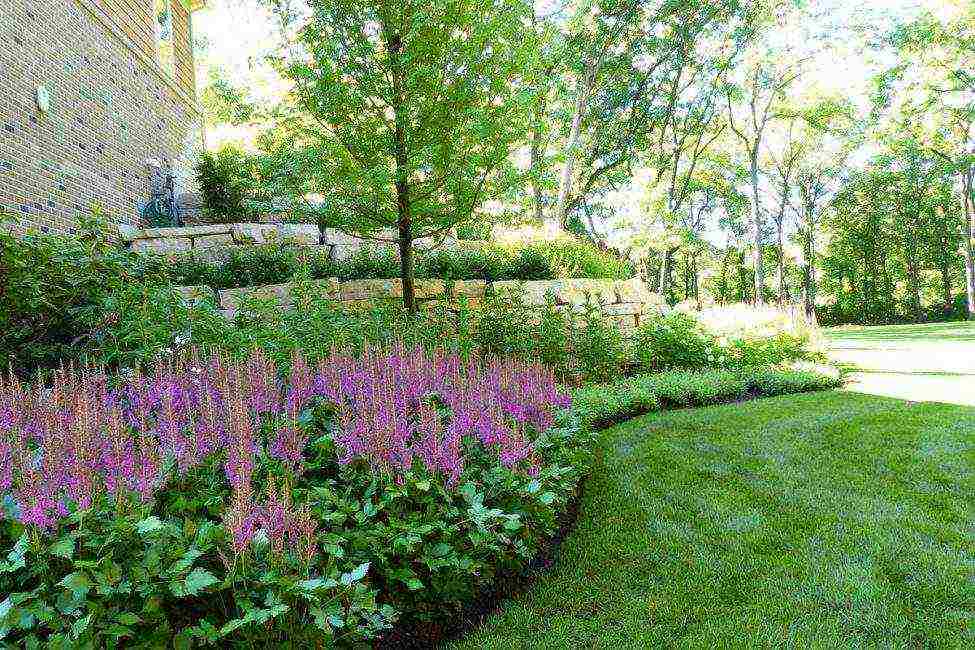
Flowerbed with astilbe
There are sun-loving varieties, but there are few of them. They are distinguished by early or late flowering. The same species, which bloom in the middle of summer, are recommended to be planted in the shade.
back to menu ↑ Soil
A plant can grow on any land. If possible, you need to choose places with a location of groundwater close to the surface.
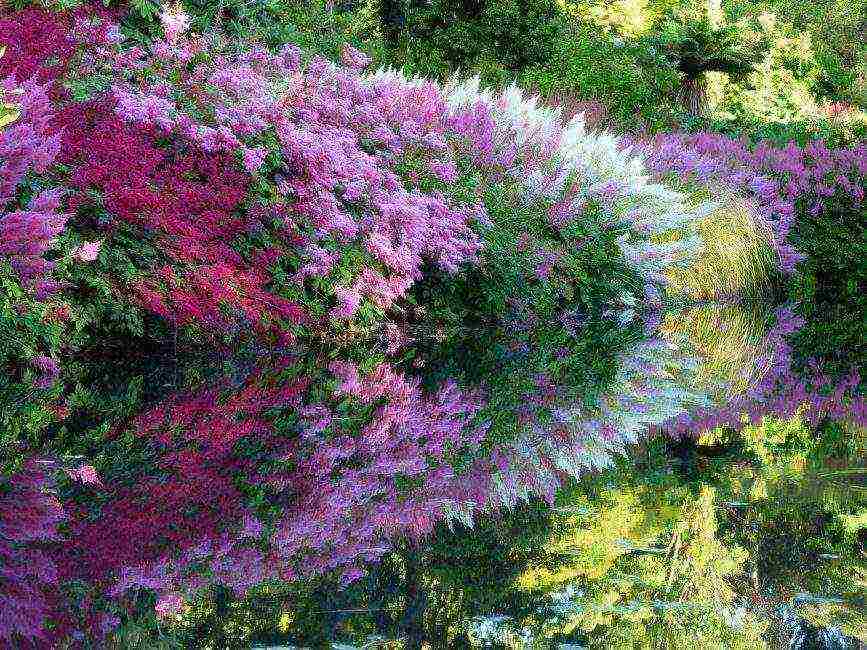
Astilbe near the reservoir
Preparing the soil for planting:
- Before planting, the selected place must be dug up.
- Remove the roots of other plants from the ground.
- Add humus or peat. 2 buckets are poured per square meter.
- The topsoil should contain potassium and phosphorus. To do this, add inert flour or complex mineral fertilizer. 30 - 50 grams is enough per square meter.
Astilba is not recommended to be planted near trees with shallow roots. They will fight for the incoming moisture. The fight will end unfavorably for the flower.
back to menu ↑ Landing 
Planting astilba is best done in the fall.
The air temperature should be kept from 5 degrees Celsius and above. The distance between the bushes should be 30 cm for dwarf and low varieties, and 50 cm for medium and tall ones.
Step-by-step instruction:
- Dig a hole to a depth of 30 cm.
- Add fertilizer and water.
- Plant an astilbe bush.
- Cover with mulch on top. The layer must be at least 3 cm.
In the first year after planting, astilbe is gaining color. Experienced flower growers recommend cutting the buds. A fragile plant will give all its strength to the inflorescences and may die.
back to menu ↑ Care
Taking care of astilba bushes is easy. The main thing is to comply with the basic rules.
back to menu ↑ Watering
Astilba is hygrophilous. She needs to ensure an adequate supply of water, so watering should be regular.
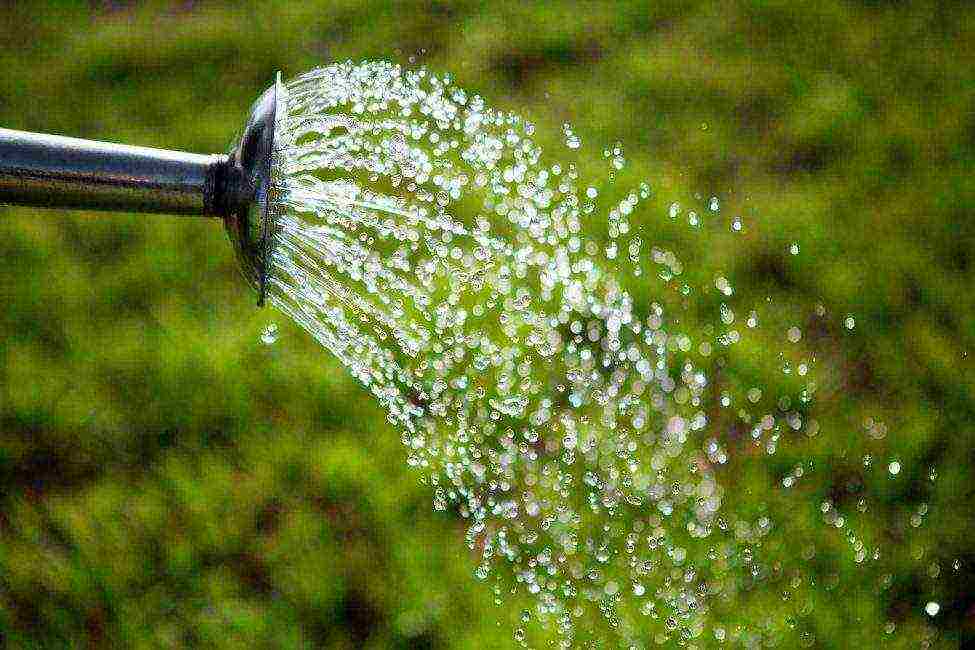
Do not allow the soil to dry out
Even a minimal lack of moisture has a deplorable effect on the plant. It becomes lethargic, flowers fade. It very quickly becomes sloppy in appearance and withers.
back to menu ↑ Weed weeding
Thanks to its powerful root system, Astilba drowns out weeds. You need to weed young bushes. After the rain, the sprouted grass breaks out.
The soil must be loosened. A crust must not be allowed to form on it. By the way, if the plant is mulched, then weeding and loosening is not required.
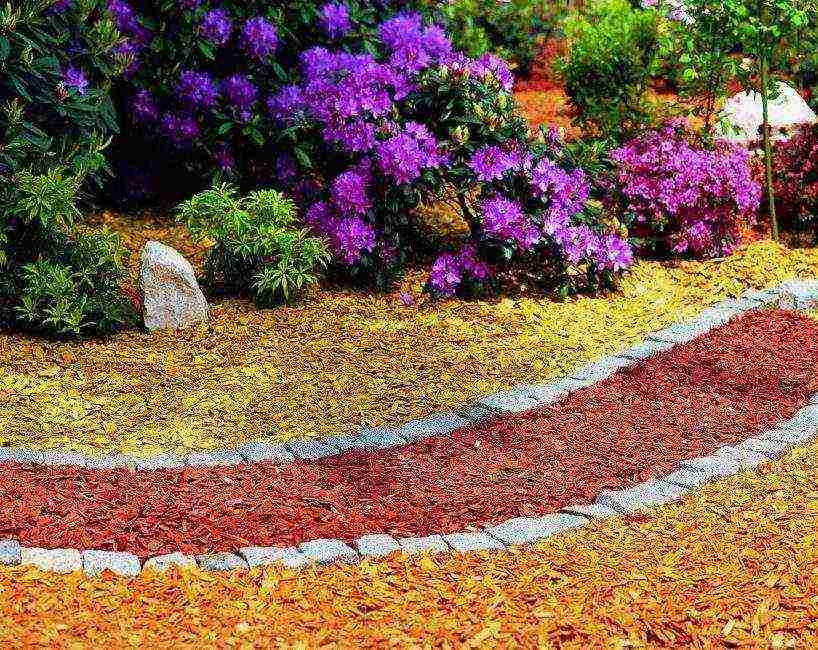
Decorative mulch application
Peat mulch protects the root system well... Moreover, it prolongs the youth of astilba by the fact that the renewal buds are constantly covered with a layer of earth.
back to menu ↑ Fertilizers 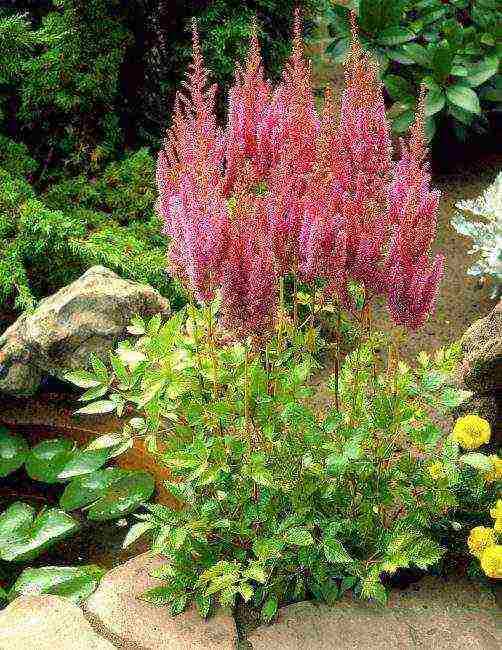
Astilba near an artificial reservoir
Top dressing of the bushes is carried out every year. The choice of fertilizer depends on the quality of the soil:
- If astilba grows in moist soil, then it is fed with complex mineral fertilizers.
- When the plant is planted in dry ground, compost and peat are used.
Organic fertilizers make foliage more lush and luscious. For this, the bushes are watered with diluted manure. If you want to extend the flowering period, you need to feed it with a mixture of urea and superphosphate in the summer.
back to menu ↑ Transfer
Astilbes have a maximum life span of 20 years. At the same time, it is recommended to transplant it every 5 years.... Subject to regular mulching, the procedure can be carried out after 7 years.

The transplant procedure rejuvenates the plant and prolongs its life.
You can transplant the bushes in the spring before bud break and in the fall after flowering. The dug out plant can be transplanted as a whole, or it can be divided into several parts. This process is described above, in the paragraph on reproduction by division.
After transplanting, the soil must be compacted and watered. This promotes survival.
back to menu ↑ Neighbors of Astilba
Astilba gets along well with other plants. This allows you to select the neighborhood to taste, creating beautiful landscape compositions. Often it is planted on stony soils, rock gardens, near water bodies.
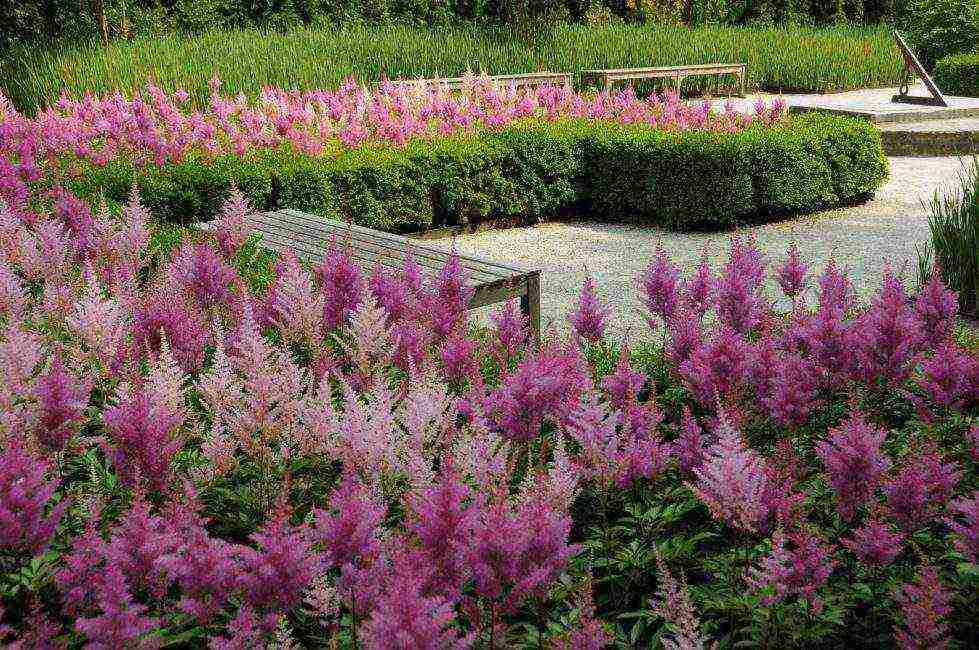
Astilbe in landscape design
The delicate foliage of astilba is very well combined with hellebore bushes. Tulips, lilies of the valley, irises planted next to it look beautiful.
back to menu ↑ Astilba distillation
Astilbe can be used for forcing in winter. Samples no older than 3 years are suitable.
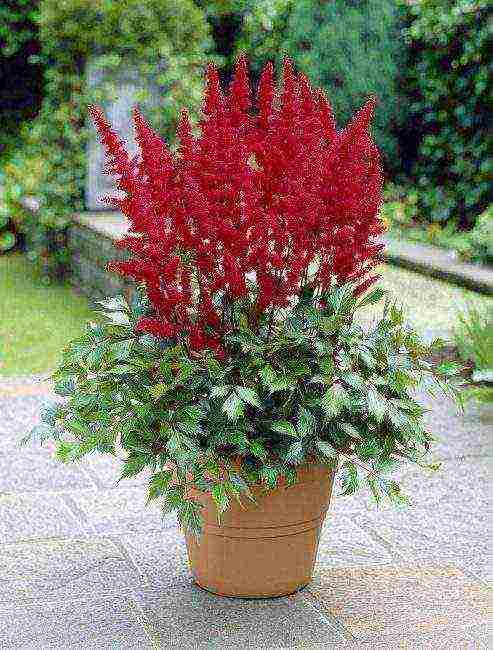
Astilba grown in a pot
Step-by-step instruction:
- The selected bush is dug up and planted in pots about 15 cm deep. The procedure should be carried out at the end of September.
- The substrate should consist of sod and leafy soil, compost and sand. The proportion is 1: 1: 1: 0.5, respectively.
- The pots are placed in a greenhouse. They need abundant watering and shading.
- Before the onset of frost, a structure of frames is armed over the bush and insulated.
- In December, the pots with the plant are transferred to a room with a temperature of no higher than 12 degrees.
- During this period, watering should be moderate.
- Shoots will begin to grow after about 3 weeks. This is a signal for the resumption of abundant watering and an increase in temperature to 18-20 degrees.
From the moment the shoots appear until flowering, it takes about 45 days. When forcing on one bush, up to 7 inflorescences are formed.
If sprouts that have grown by 8 cm are sprayed with a gibbersib solution, this will accelerate the blooming of flowers. This preparation also helps the plant to form more inflorescences.
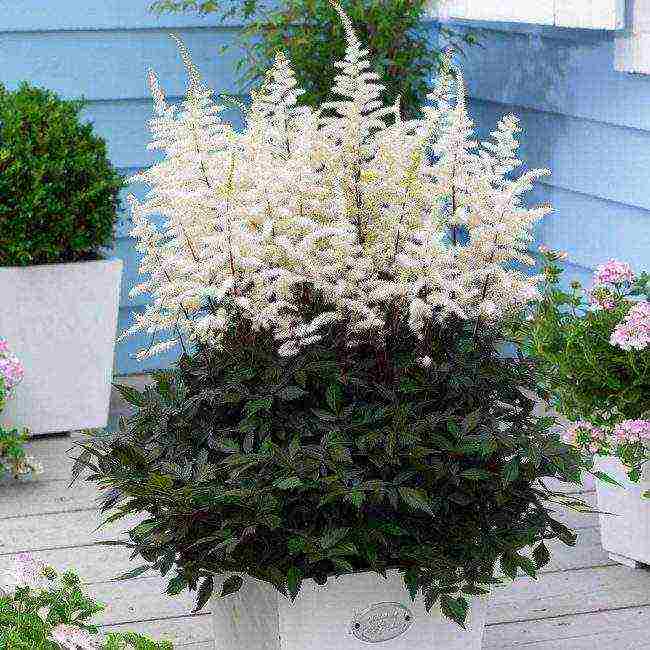
After distillation, the plant is returned to the open ground, or can be left in a pot as a houseplant
The following varieties are suitable for forcing:
- Fenel
- Cologne
- Red Santinel
- Berg Crystal
- Federsee
back to menu ↑ Pests and diseases
Astilba is in good health. She rarely gets sick and is attacked by pests. However, this happens and the plant cannot be left unattended. Diseases can lead to her death.
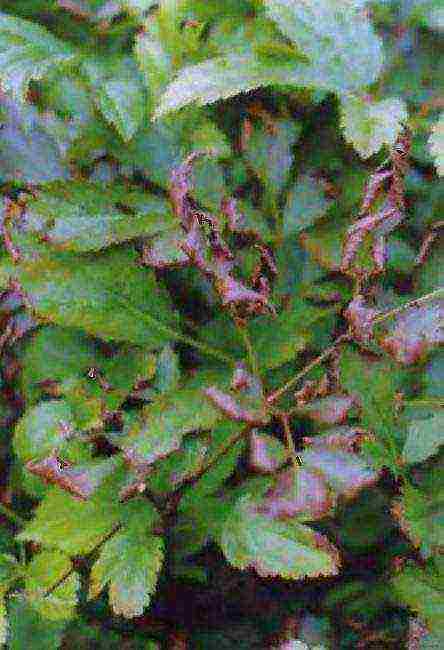
Affected foliage of astilba
Pests:
Slobbering penny - these are small insects no more than 5 mm long. They leave their eggs on the leaves underneath or on young branches near the leaf petioles. These larvae secrete mucus, which foams a lot. It protects insects from chemicals. Therefore, you can only remove their leaves with your hands.
You can try to apply insecticides, with a large invasion of pests on the bush. These pests stop the development of astilba. It stops blooming. Leaves wrinkle, wither and fall off.
Strawberry nematode - is a small worm. They feed on the sap of the foliage. You can find them in the spring, when new leaves bloom:
- Young shoots and petioles gradually become thicker
- Brown blotches are visible on the sheets
- Their shape can be deformed
- Sheets curl
There are no ways to combat this pest. The infected astilde must be dug up with a clod of earth and destroyed. It is best to burn it outside the garden. Sprinkle the land where it grew with a hot solution of potassium permanganate.
Gall nematode - these are also worms, only half the size. It strikes the roots of astilba. Signs of this pest: rotting roots, twisted leaves, stopping the growth and development of the bush. If found immediately, then the drug Fitoverm can help. In case of severe damage, the bush must be destroyed, and the soil must be treated with a solution of potassium permanganate.
Slugs, collected by hand or set traps on them. They also cannot stand garlic and mustard. You can try to prepare an infusion and process the plant with it.
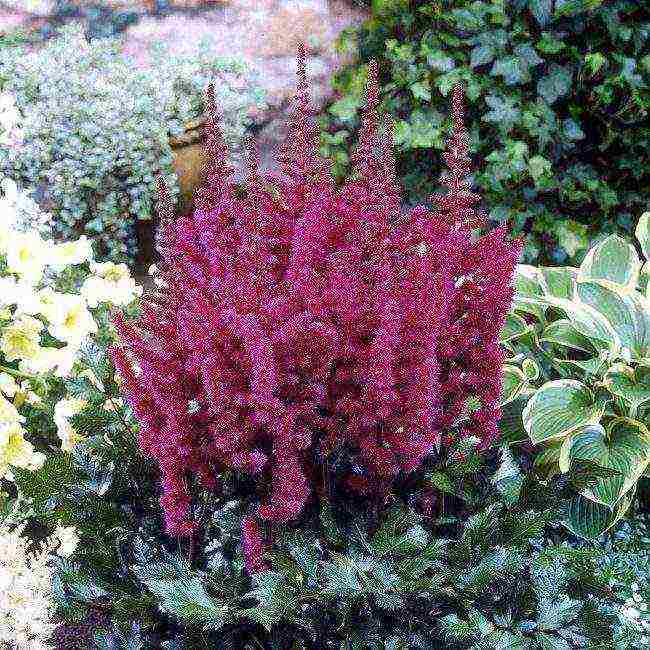
Well-groomed and healthy plant
Diseases:
Root rot may occur due to excess moisture. This happens if astilbe grows on moist soil, while it is abundantly flooded with water. It is dangerous for young, fragile bushes, leading to their death. It is easier for a strong plant to deal with it.
It is expressed by the fact that the foliage at the edges begins to turn brown, curl, dry.
Anti-rot measures:
- You need to dig a bush
- Remove affected roots and foliage
- Treat the roots with a weak solution of potassium permanganate
- Transplant to a new, drier place
The land where astilbe grew is also treated with potassium permanganate. It is not recommended to plant flowers there for at least a year.
- Bacterial spot - affects the leaves. Expressed in black spots on foliage. The plant begins to wither. Removable with copper-based preparations.
- Viruses and phytoplasmic diseases - are not amenable to treatment. They do not appear on growing bushes. Either an infected seedling was purchased, or a substrate with a virus was added to the soil. The plant will have to be destroyed so that the disease does not spread to neighboring bushes.
back to menu ↑ Medicinal properties of Astilba 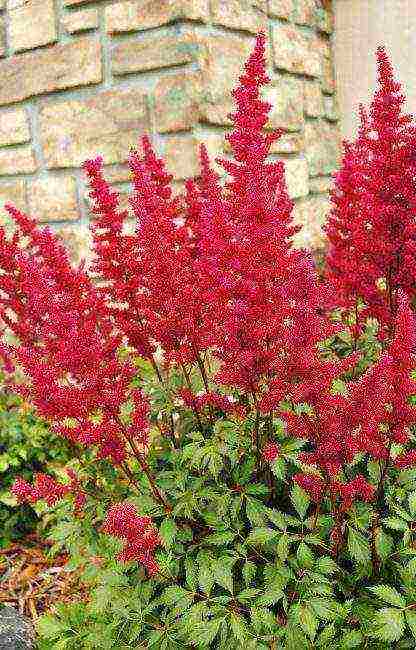
Astilbe - bright and unusual
Traditional medicine and pharmacology do not use the properties of astilba. They are used in folk medicine and cosmetology.
List of properties:
- The roots are used in the treatment of hypertension
- The leaves have a tonic effect and are used in the treatment of kidney diseases
- Stems help to reduce fever, relieve inflammation, treat skin diseases
Ointments, infusions, decoctions are made from various parts of astilba. In addition to treating diseases, they are used in cosmetology. So if you wash your face with her infusion in the morning, then it will relieve acne.
Infusion from the roots:
- 50 g of roots, peel and rinse
- Pour 0.5 liters of boiling water
- Insist in a thermos for 12 hours
- Strain, you can use
Leaf infusion:
- Take 15 gr. fresh leaves. Rinse them with running water
- Pour a glass of boiling water
- Insist 15 minutes. Ready to eat
For medicinal purposes, use strictly under the supervision of a physician!
Read also:
- Anemones: 25 species, features of reproduction and care, planting in open ground, forcing in winter, a description of the medicinal properties of the plant (50+ Photos & Videos) + Reviews
- Physalis: description, growing seedlings, planting in open ground and caring for it, useful medical and culinary properties (30 Photos & Videos) + Reviews
- Ageratum: description, planting in open ground and caring for it at home (30+ Photos & Videos) + Reviews
- Aquilegia: the 25 most common species, the rules of planting, care and reproduction (70+ Photos & Videos) + Reviews
8.3 Overall Score
Astilba will decorate any site. It will look spectacular in independent plantings and in compositions with other plants. She will not only cheer you up with her beauty, but her infusions will also benefit your skin. Your opinion about this material is very important to us. If you disagree with these ratings, leave your rating in the comments with the reasoning for your choice. Thank you for your participation. Your opinion will be useful to other users.
Add your review
Astilba rentsa behaves well enough both in too shaded and sunny, bright places. And pests appear on it very rarely.
Often, many gardeners wonder how to plant a plant on their own land plot so that it is unpretentious in maintenance and at the same time pleasing to the eye with its bright and beautiful flowering. In this case, you should pay attention to the plant called astilba lensa. Therefore, we will consider how to care for and grow it on our own land.
Astilba rentsa behaves well enough both in too shaded and sunny, bright places. And pests appear on it very rarely.
Often, many gardeners wonder how to plant a plant on their own land plot so that it is unpretentious in maintenance and at the same time pleasing to the eye with its bright and beautiful flowering. In this case, you should pay attention to the plant called astilba lensa. Therefore, we will consider how to care for and grow it on our own land.
Flower features
Such a plant known today as astilba belongs to herbaceous perennials, which are part of the saxifrage family. Translated, this name means "without shine" and this is not surprising. Back in Scotland, the previously famous Lord Hamilton, who gave this plant a similar name, noticed that its leaves have absolutely no sheen and are almost dull. For the first time, astilba appeared on the territory of the Japanese islands, North America and in the east of Asia. You can meet her most often on the banks of streams and in deciduous forests, since she is very fond of moderate humidity. In Europe, this plant appeared around the beginning of the 19th century.
Clairvoyant Baba Nina named the signs of the zodiac, on which money will fall from the sky in May 2018 ...
►
This flower is a rhizome plant. Moreover, in winter, its upper part completely dies off. Astilba has stems that are erect. Their height can range from 8 cm and up to 2 m. This will depend primarily on the variety or the type of the plant itself. The leaves can be both long-petiolate and dentate or pinnate. Astilba can be red-green to dark green in color. The rhizome is quite loose, but at the same time very dense. On the upper part of the root, new buds form from year to year, and those below it simply die off. In the vertical direction, the growth of this plant per year can be 3-5 cm. Due to this, in winter, it is advisable to add fertile soil to the root.
The flowers of this plant look like the so-called apical inflorescences, which consist of very small flowers of purple, red, white, purple and pink shades. They begin to bloom around the beginning of June until the end of August. In this case, the inflorescences can have a pyramidal, rhombic or paniculate shape. Those plants in which drooping inflorescences are found are quite beautiful. Their length can be 10-60 cm. As for the astilbe fruit, it is a box.
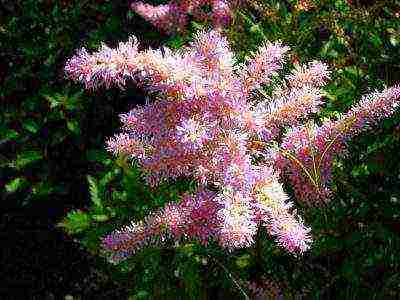
Varieties of astilba
Today, you can count about 200 all kinds of this plant, which can easily grow on the territory of our country. Most often, the following varieties are used in the growing process, which are the most unpretentious. So, there is astilba:
- Garnet;
- bergkrystal;
- amethyst;
- Gloria is pale pink;
- Fenel red garnet;
- Weiss Pearl creamy white;
- hyacinth light lilac;
- Chinese;
- Japanese;
- astilbe Thunberg.
Naturally, each of these plants has its own unique characteristics that set them apart from each other. But one of the most noticeable and beautiful species is the astilba arensa amethyst variety. Its main feature lies in the shade of the flowers, which have a purple-lilac hue, exactly the same as the color of the gemstone called amethyst.
Which of the proposed varieties you choose does not matter, since they can be perfectly combined with each other. This will make your garden bright enough by using all sorts of shades of this plant. At the same time, it will grow in highly shaded or rather warm places.

Reproduction methods
In the event that you want to breed a plant such as Astilba Arensa, you should know that there is a vegetative and seed breeding method. We will consider the information in more detail about each of them.
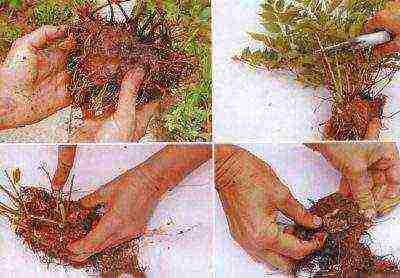
The simplest and most effective method is vegetative propagation, which uses the so-called division of the bush. In order to carry out such a process, it is necessary to wait until the plant is about 3-4 years old. After that, it is dug out of the land plot and its root system is divided into several fairly even parts. In this case, you need to ensure that each of the resulting parts has at least 2-3 fresh buds. In the process of dividing, pay attention to the fact that the lowest part of the rhizome should be completely removed, as it will die out in any case. It is necessary to leave only the upper part of the root, where the growth will take place in the future. So that after dividing the roots do not dry out, you should immediately dig them into the ground.
The best option for this would be spring. If you want to carry out this process at the beginning of autumn, then you must make sure that the rhizome of the plant has time to take root in the ground until the frost occurs. With proper reproduction, the first flowers will appear on the plant next year.
You can also find an option when astilbe is bred using ordinary sowing of seeds. But this can most often be found in those cases when they are trying to get some kind of new variety. The first difficulty that can arise in the process of working with seeds is their very small size. They can only be seen through a magnifying glass. For example, about 20 thousand seeds fall on 1 g. If you still want to get seeds, you need to cut off all the inflorescences at the onset of September and leave them in a sufficiently warm and dry place. Literally after 2-3 weeks, shake off the panicles and remove the seeds.
Sowing is recommended around February or March. In this case, you must find a small box or a pot, the height of which does not exceed 15 cm.They need to be placed in a greenhouse or kept indoors. Sufficiently fertile soil is needed in the box, it is worth tamping it well and pouring it abundantly with water. After that, seeds must be poured onto the surface of the soil without further embedding. In order to maintain moisture, the ground must be covered with dense polyethylene or glass. Seeds should be watered only from a spray bottle. Literally after 3 weeks, the first shoots will begin to appear in the box. As soon as the leaves begin to form in the seedlings, they must be dived immediately. At the onset of summer or autumn, they need to be planted in open ground.
Planting and caring for this plant
If you are looking for the perfect place to plant astilba, then in this case you should give preference to those areas that have diffused light. As for the choice of soil in which this plant will grow, peat and even loamy soil may be suitable for astilba. At the same time, it is necessary to ensure that at the stage of the growing season it always has high humidity. You should also pay attention to the fact that in some areas there is no waterlogging of the earth, as this can lead to damping out of plants in the future. The most favorable place for astilba is the surface near any ponds, pools or even fountains.
If you decide to plant this plant in a flower garden, you need to ensure that the distance between individual bushes is at least 30-40 cm.When planting astilbe, see that the rhizome is immersed in the ground by about 20-25 cm.Above the new buds, a layer the land should be no more than 3 cm. After the plant is planted, it is necessary to proceed to the process of mulching with a layer of humus or peat. This will make it possible not only to prevent the formation of weeds, but also to keep the moisture necessary for the plant in the soil for a longer time. In this case, the thickness of the layer should be such that the astilba buds are covered. You need to water it in a fairly hot and sunny weather.
It should be noted that in some varieties of this plant, over time, the rhizome is exposed. And this leads to the fact that its upper part simply begins to rise above the ground. In this case, if you do not cover the rhizome, then the buds will be in unfavorable conditions for themselves. This will lead to the fact that the inflorescences become small enough, and the flowering will not occur as actively as we would like. This situation is due to the fact that the plant grew for a very long time in the same place. Therefore, in these cases, astilba must be transplanted at least 1 time in 5 years to a completely different place.
The vegetation of this plant in the spring begins very late. This happens most often when the air temperature outside is kept within 10 ° C. Therefore, if spring is cold enough for a long period of time, then astilbe will begin to grow actively around the beginning of June. It will bloom for 3 weeks. As soon as this process is over, many experts immediately recommend cutting off all inflorescences that have faded in order to preserve all the decorativeness of such plantings. It is not worth sheltering astilba for the winter, since it is a real frost-resistant plant.
And a little about secrets ...
The story of one of our readers Irina Volodina:
I was especially depressed by the eyes, surrounded by large wrinkles plus dark circles and swelling. How to remove wrinkles and bags under the eyes completely? How to deal with swelling and redness? But nothing ages or rejuvenates a person as much as his eyes.
But how to rejuvenate them? Plastic surgery? Recognized - not less than 5 thousand dollars.Hardware procedures - photorejuvenation, gas-liquid pilling, radiolifting, laser facelift? Slightly more affordable - the course costs 1.5-2 thousand dollars. And when to find all this time? And it's still expensive. Especially now. Therefore, for myself, I chose a different way ...
Read the article >>
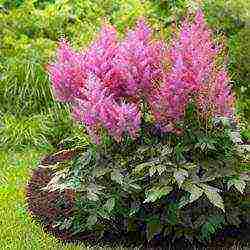 This perennial culture grows beautifully and adorns a shady garden with its unusual flowers. Within the framework of this article, we will figure out how to plant and care for astilbe in the open field. Observing the simple rules of agricultural technology, you can achieve an excellent result in growing this plant.
This perennial culture grows beautifully and adorns a shady garden with its unusual flowers. Within the framework of this article, we will figure out how to plant and care for astilbe in the open field. Observing the simple rules of agricultural technology, you can achieve an excellent result in growing this plant.
Description of the plant - varieties and varieties
Astilba is a rhizome perennial of the saxifrage family. In summer, curly bushes with lovely inflorescences are very decorative, in winter the herbaceous aboveground part of the plant dies off. Different plant varieties have different heights - from 8 cm to 2 m. Astilba leaves are feathery, complexly dissected, green or brownish in color. There are varieties with white, pink and lilac flowers.
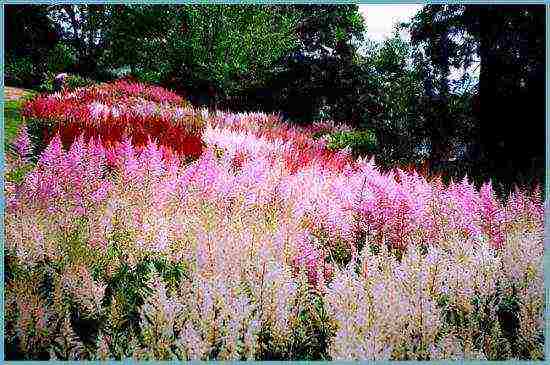
Astilba has many shades
Astilba bloom begins in early summer and lasts for about a month. During this period, the plant is most decorative. Astilbe with curly inflorescences - panicles - serve as an excellent decoration for park areas, gardens, squares and are often used to decorate territories in landscape design.
The culture is characterized by high resistance in winter: the rhizomes withstand wintering at temperatures down to -37 ° C without the threat of freezing.
Important! When grown outdoors, Astilba prefers moist, nutritious soil and even watering from time to time. Subject to this condition, caring for a flower culture does not present any particular difficulties.
Areas of distribution of natural species of astilba
The plant is found naturally in Japan, America and East Asia. In Russia, the area of the plant is the Far East, where there are 2 types of astilba natural varieties.
All modern cultivated varieties of flower culture belong to the species - Astilba Arends. Medium-sized and tall forms of the plant bloom with bright inflorescences of pink or white flowers with numerous transitions and shades.
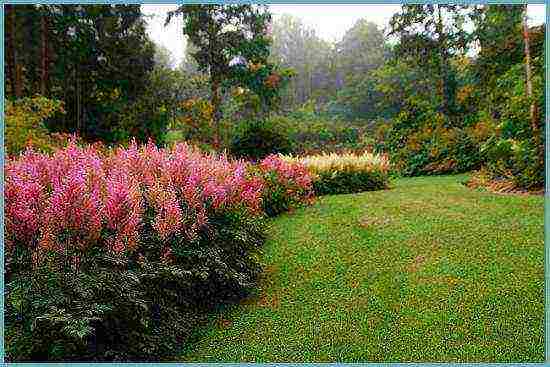
Astilba in landscape design
Astilba hybrid cultivars are widely used in landscape design. During flowering, the bushes form airy curtains of pink or purple hues. Plants are characterized by compact size and abundant flowering. Planting hybrid astilba in groups with other species allows you to perfectly shade lawns and conifers during flowering. The combination of plants with different color tones enlivens the parkland areas.
An interesting type of astilba Thunberg, which has not typical for the species, drooping brushes of yellowish or pink flowers.
Early flowering astilbe of a wide range of colors of white and pink tones belong to the species "Japanese Astilba". This type of astilba is highly decorative.
Astilba: planting and care
When planting plants, the quality of the planting material is of great importance. In order for the plant survival rate to be one hundred percent, it is worth considering some of the requirements for the rhizomes intended for planting.
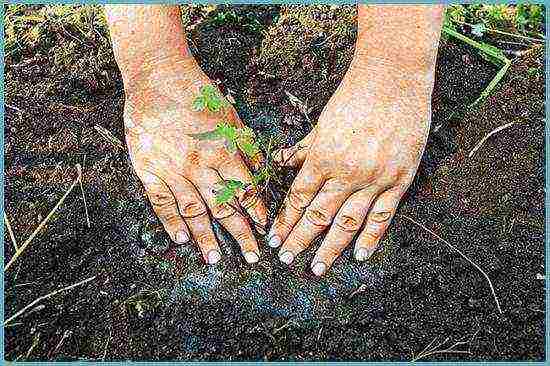
Landing astilba
Important! Astilba rhizomes should not have dead, rotten parts. Overdrying or excessive moisture of the planting material is not allowed during storage. Young shoots should not be elongated, curved or wrinkled.
Of course, specimens with elongated sprouts can also take root, but then the plant can lose its decorative effect and hurt for a long time.
Choosing a comfortable place for a flower
It should be remembered that astilba is a plant for partial shade, bright sunlight is destructive for it. Planting a flower culture in open, unprotected spaces from sunlight is undesirable.
In addition, flowers do not respond well to areas with high groundwater levels and stagnant water. This leads to the soaking and damping of the rhizomes. Cultivation of a crop in such areas will not do without a reliable drainage device. And if it is not possible to equip it, you need to choose a higher place for planting plants.
Planting astilba in the open field: determine the size of the holes
The depth of the planting pit is required to be provided individually for each plant, taking into account the size of the rhizome. The root system of the astilba should be freely placed in the planting pit, while deepening the bush or filling the growth point with soil is not allowed. A hydrogel can be added to the bottom of the pits, it will help maintain soil moisture; as well as bone meal, ash and mineral fertilizers - 1 matchbox each.

Astilba should be planted in a well-moistened soil.
The surface of the earth can be mulched with bark or peat chips, which will keep the soil evenly moist, and in the future, will protect the roots of the plant from drying out.
Plant care
Astilbe bushes grow by about 3-5 cm in height per year. Plant care measures are reduced to adding soil under the bare parts of the rhizome. Fertile soil is added in a layer of 2-3 cm.
Planting maintenance requires maintaining soil moisture. To do this, add a mulching layer (peat, bark, expanded clay or landscape crushed stone) on top of the planting soil. In winter, mulch on the surface of the soil helps to protect delicate rhizomes from freezing.
The combination of uniform watering and keeping the soil moist is the key to plant health and lush flowering.

Caring for astilbe is very simple
The decorativeness of the plant is supported by periodic pruning of dead stems. It is necessary to regularly remove faded inflorescences from the bushes, this is especially true when using astilba in landscape design when decorating territories.
Fertilization and feeding
The introduction of fertilizers under the bushes of astilba during planting has already been mentioned above.
For the full development of the plant, it is required to carry out regular feeding with complex fertilizers. Considering that astilba can grow in one place without transplanting and dividing rhizomes for more than 5 years, it is necessary to feed the plants with nitrogen fertilizers from the beginning of spring. This helps new foliage grow quickly on overwintered bushes.
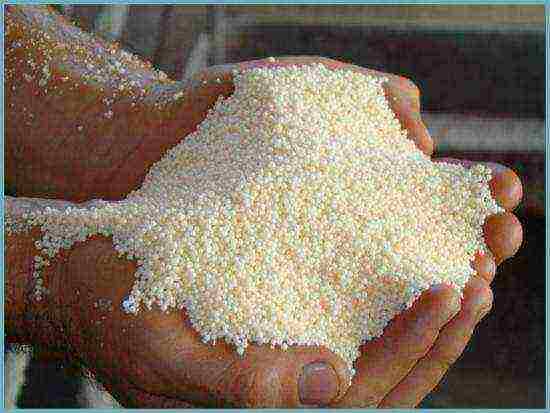
Do not forget to feed Astilba with mineral fertilizers
During flowering, the crop must be fertilized with phosphorus, and by the end of flowering - with potash fertilizers. This will help to increase the timing and splendor of flowering, and also stimulates the formation of full-fledged seeds.
Plant propagation
Seed propagation
To preserve the decorative and varietal characteristics of the plant, propagation of perennials by seeds is not accepted. Crops grown from seeds often do not correspond to the declared varietal characteristics:
- have a changed color;
- sparse flower tassels;
- low decorative effect;
- short flowering times.
For seed propagation, only high-quality seeds of varietal selection can be used.
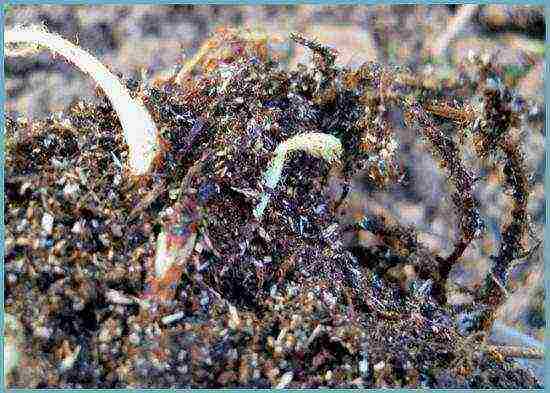
Astilba seed sprouts
The seeds of the plant are sown on the surface of the moistened soil, without covering them up. For accelerated germination, high humidity is maintained (you can cover the crops with glass or keep them in a greenhouse). Growing astilba seedlings is reduced to the timely watering of seedlings. At this time, it is especially dangerous to dry out young plants. They need to be protected from direct sunlight, providing a bright place without access to scorching rays.
Excellent results in increasing germination are achieved by performing preliminary seed stratification. This agronomic technique consists of placing the seeds in a cold place (+ 4 ° C to - 4 ° C) for 3 weeks. The hardened seeds are sown in greenhouses and kept at a temperature of + 20 ° C.Young plants can be planted in a permanent place in the open field within 2-3 months after sowing. Seedlings obtained from stratified seeds are distinguished by excellent survival rate and fast growth.
Reproduction of astilba by dividing the bush
The vegetative method of reproduction of astilba (dividing the bush) is the most reliable and familiar for flower growers. The mother plant is dug up with care, taking care not to damage the delicate rhizome. With a sharp knife, the rhizome is divided into parts with 2-3 buds. The slices are sprinkled with crushed coal.
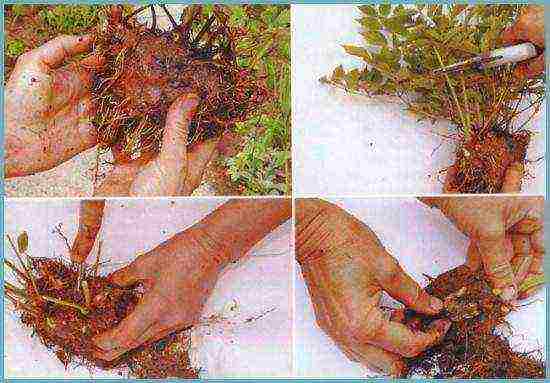
Dividing the astilbe bush
Planting material is laid out in the prepared furrow and the soil is moistened. Excellent results when planting cuttings are achieved with the use of root formation stimulants. Caring for young plants includes regular watering and loosening the soil.
Planting of astilbe cuttings can be carried out in early spring, already in March. With this method of propagation, the first flowering of young plants will begin in early autumn.
Division by the kidneys
Reproduction of a perennial is carried out in another way, which is considered the fastest - by dividing by buds. In the spring, with the beginning of the growing season of the plant, the buds of renewal are separated with a sharp knife. Cuttings are planted in a greenhouse with moist soil mixed with coarse sand or gravel, after dusting the cut with ash. With this method of reproduction, a very high survival rate of young plants is noted. The only drawback is that getting a full-fledged plant takes almost a year.
Diseases and pests
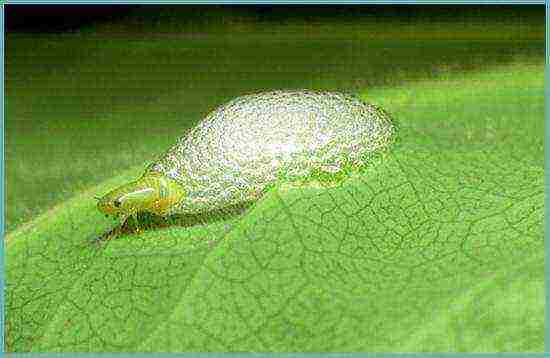
Monitor the health of your plants. In the event of pests, immediately start fighting them.
Astilba attracts not only with its decorative effect, the plant is practically not damaged by pests and diseases. Rhizomes of some crops may occasionally be affected by rootworm nematodes. The pest does not respond to the use of drugs, so the fight against the nematode is reduced to the destruction of diseased bushes. In this case, it is required to remove part of the soil that came into contact with the roots of the diseased plant. It is advisable not to plant a crop at this place for several years.
Another pest that can threaten a plant outdoors is a drooling penny. The affected plant feels depressed, the development of the leaf mass slows down. Preventive measures - collecting the pest from the leaves of the plant by hand.
Astilba: combination with other plants
Growing astilba in group plantings with other plants is quite justified. Decorative plant panicles look great near conifers with their monotonous greenery. Such a neighborhood is very preferable for astilba: conifers provide shrubs with protection from the sun.
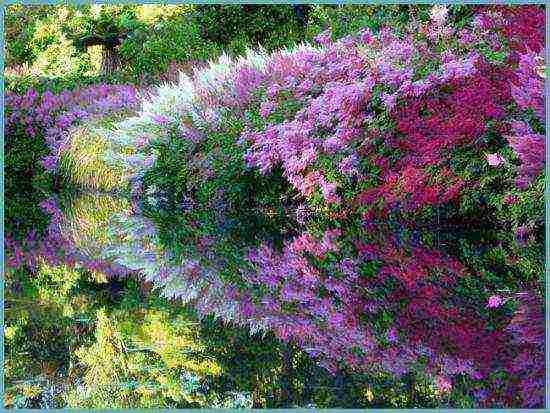
The combination of astilba of different colors in landscape design
Astilbe bushes are in perfect harmony with late tulips, irises, hosts, periwinkle. Single plantings of astilba on a green lawn in the shade are very decorative.
In landscape design, when planting in the shade, astilbe bushes fit perfectly. The plant is used for single and group plantings, creating complex landscape solutions for shady and semi-shady places. Caring for ornamental plants is absolutely no difficulty and consists in timely watering.
How to plant astilba correctly: video
Astilba: photo

